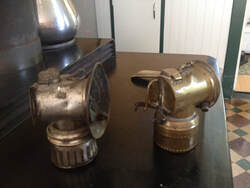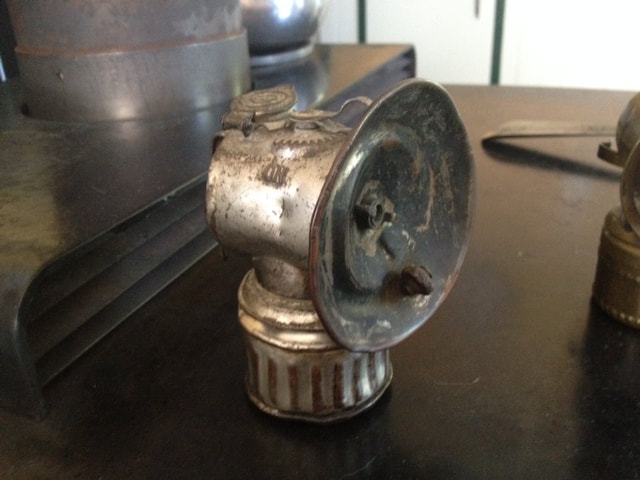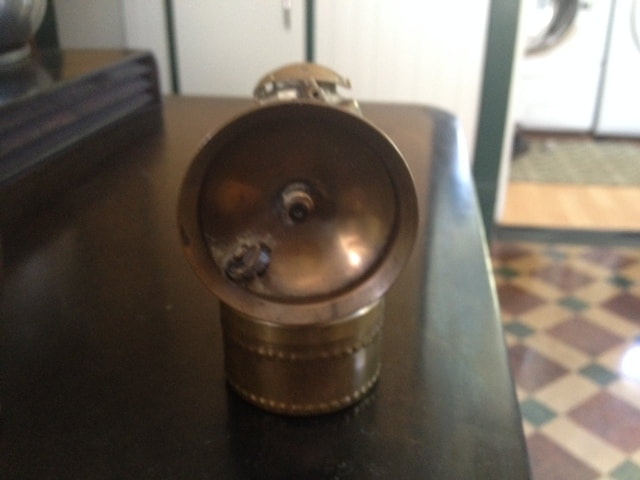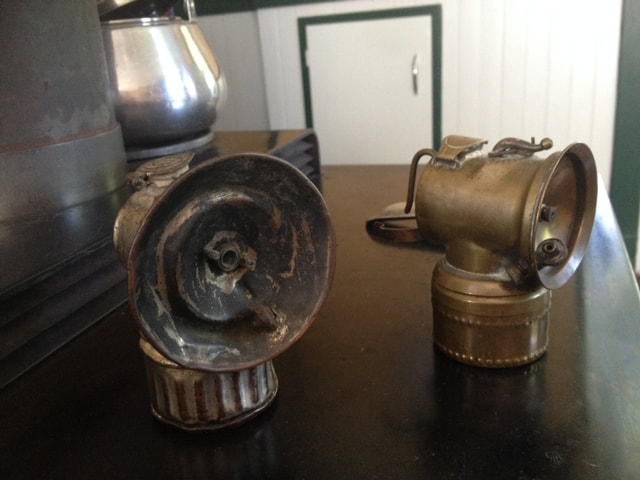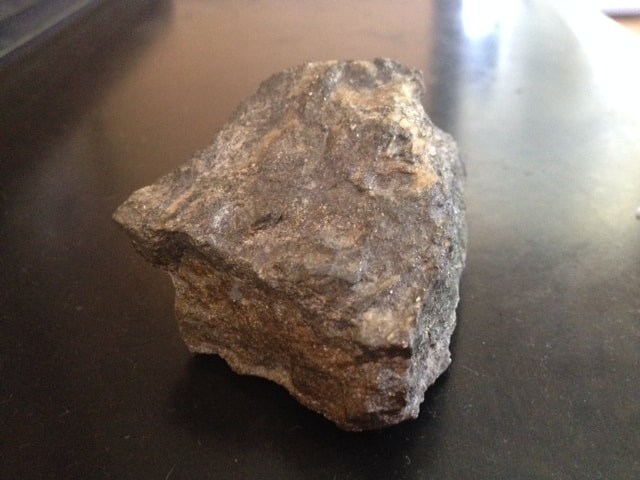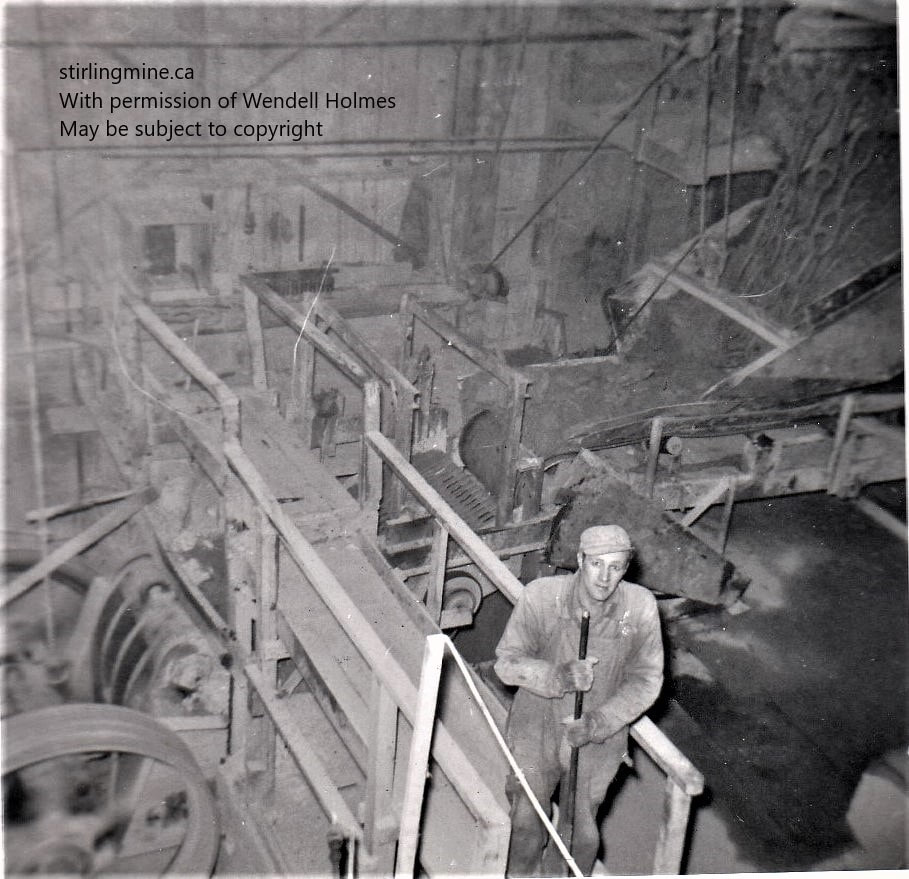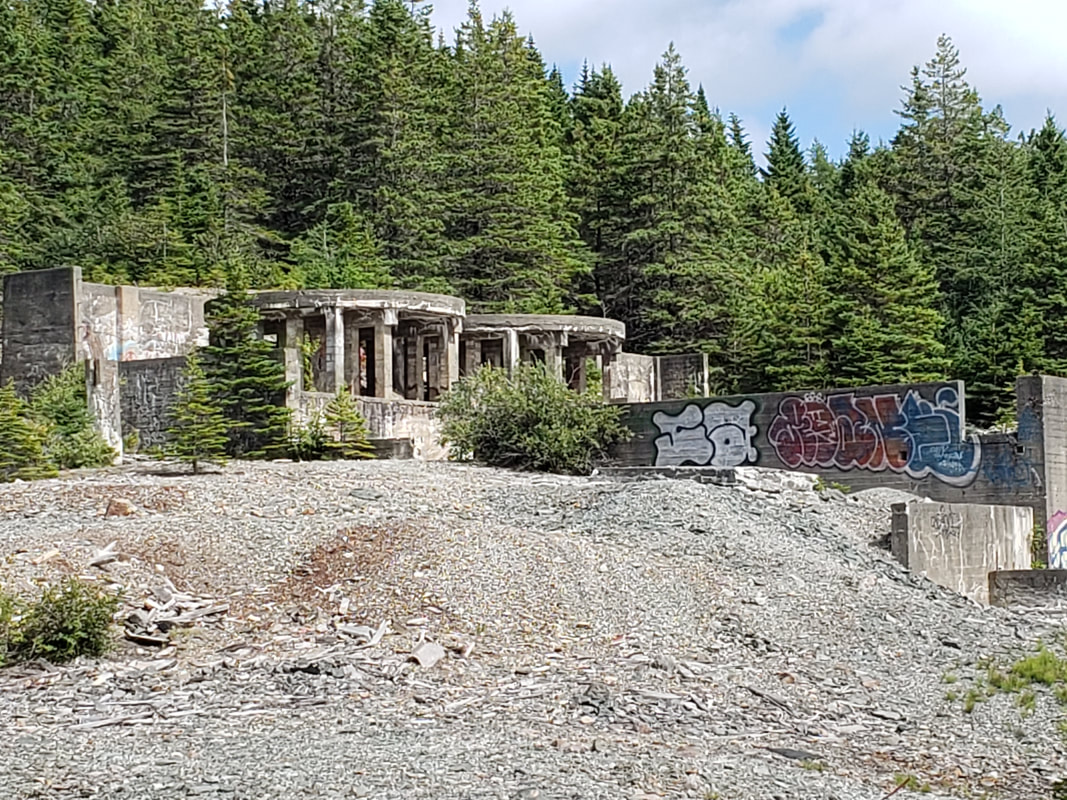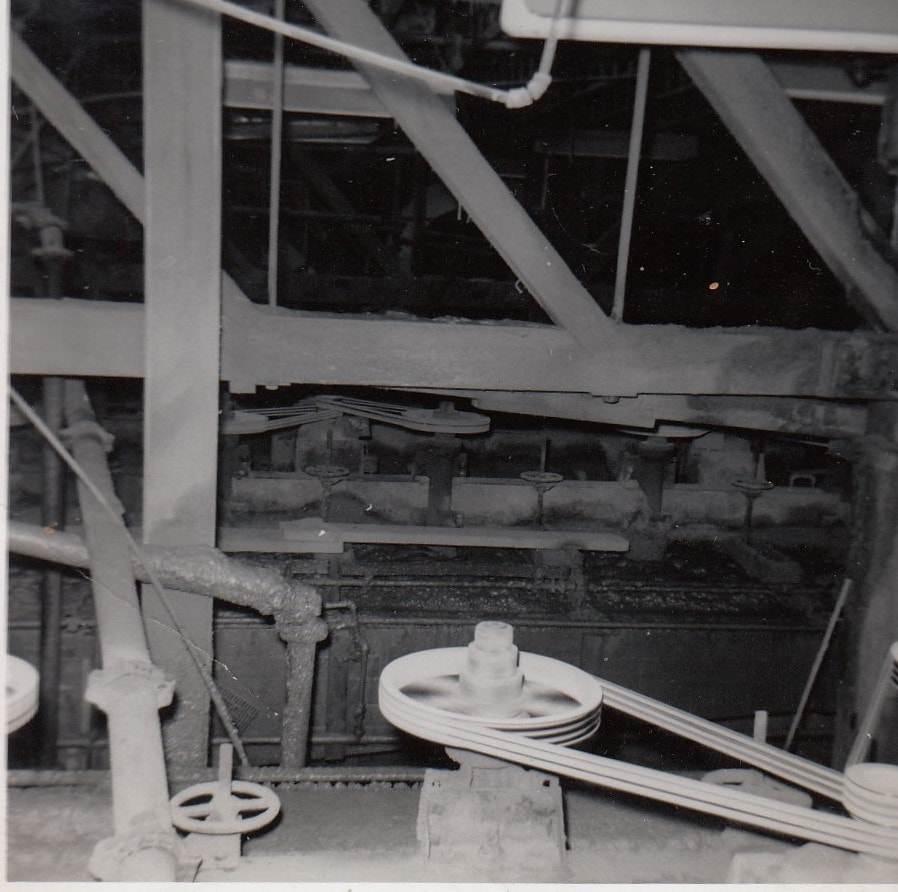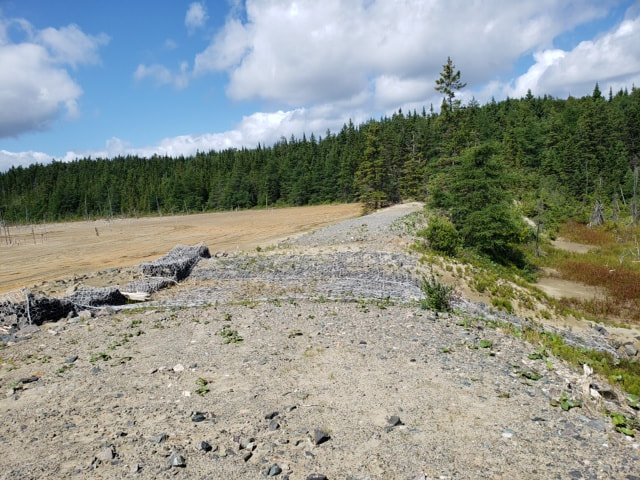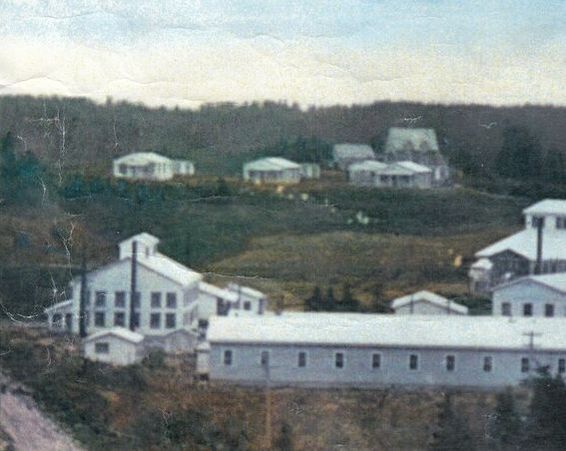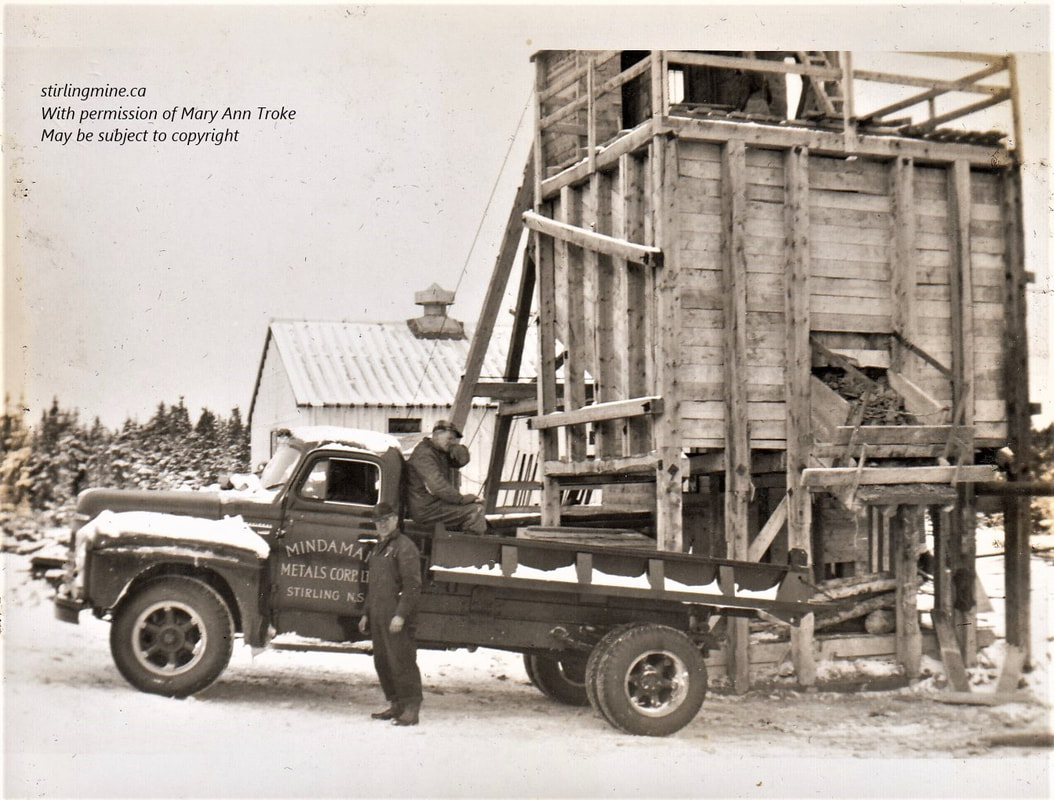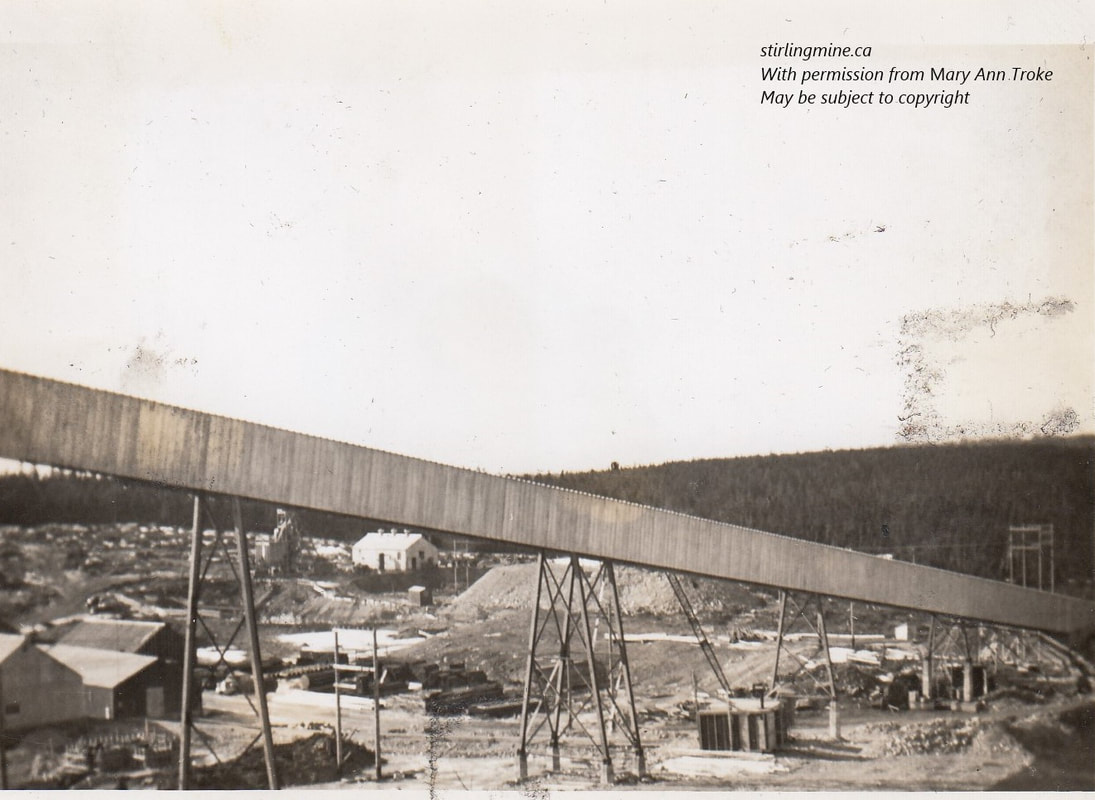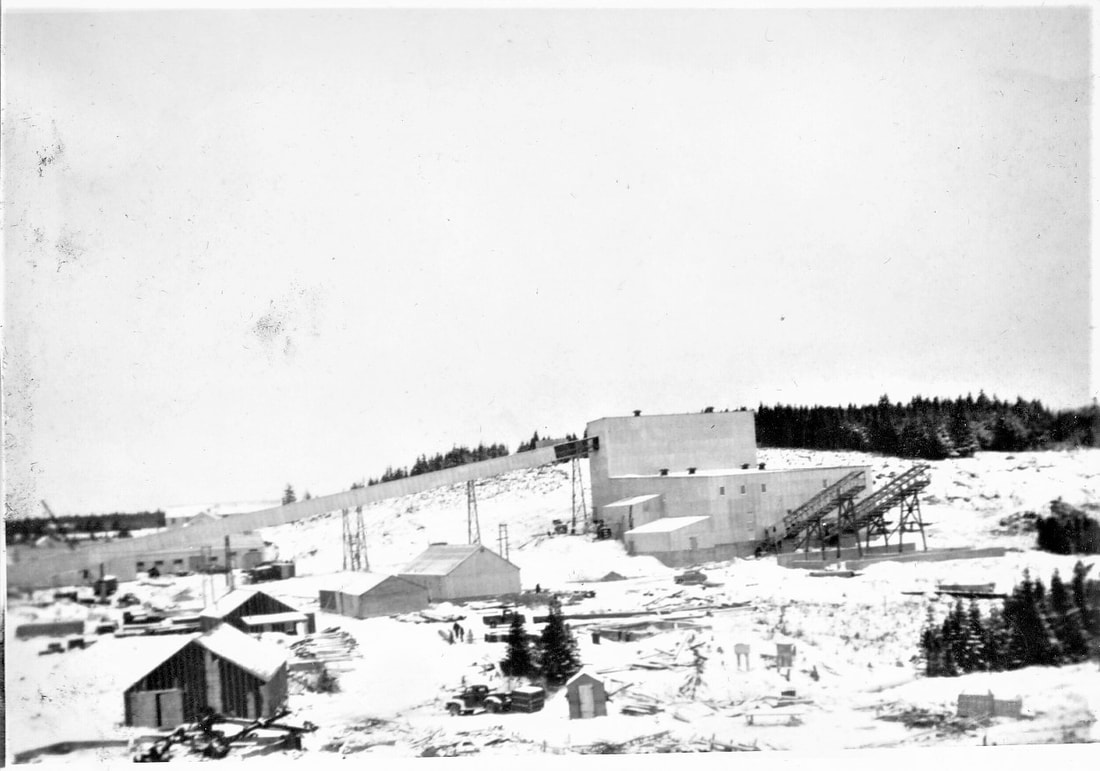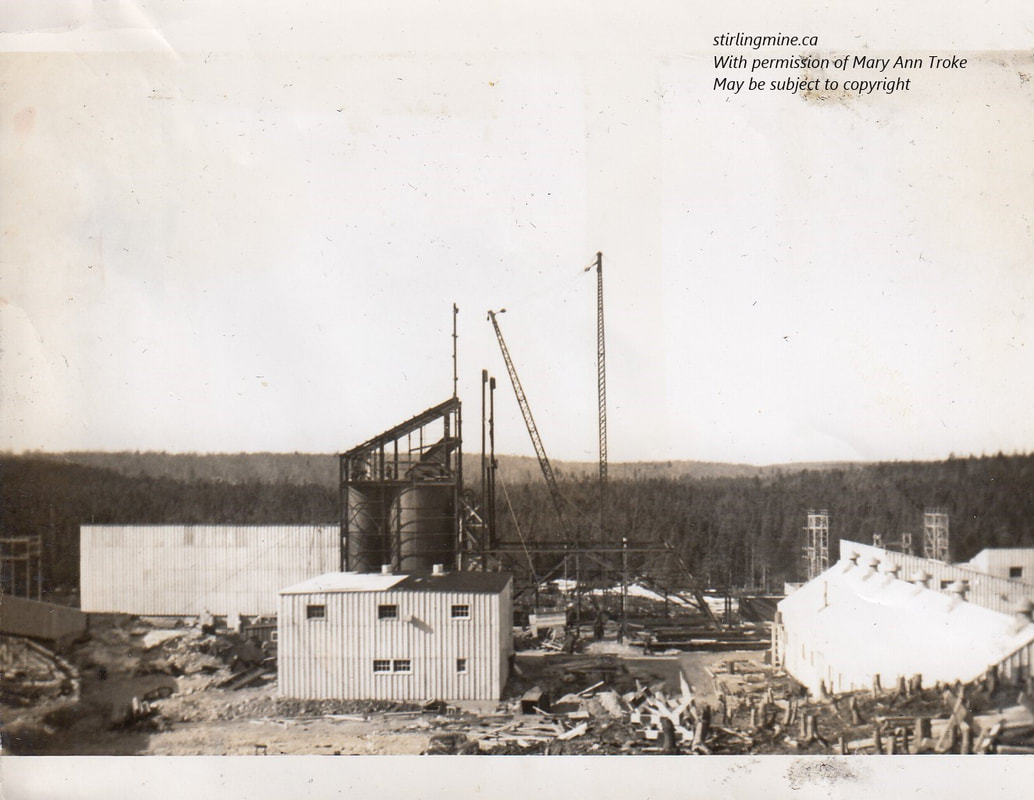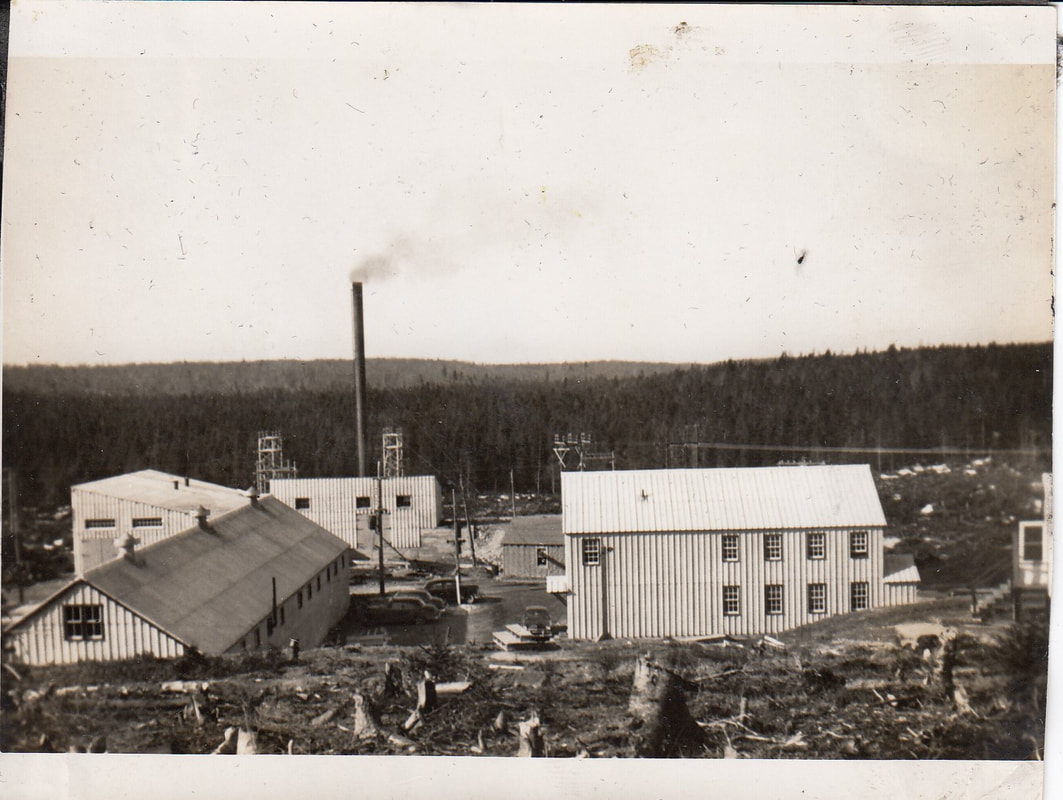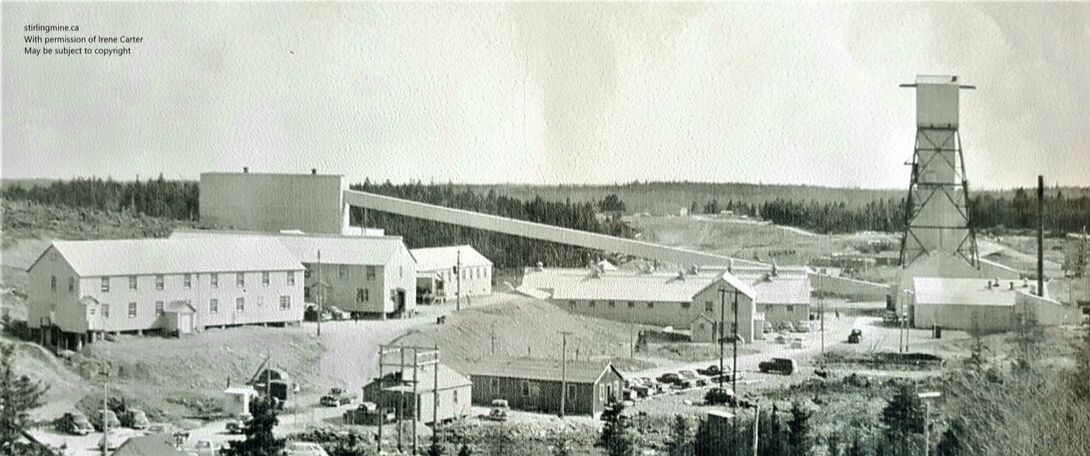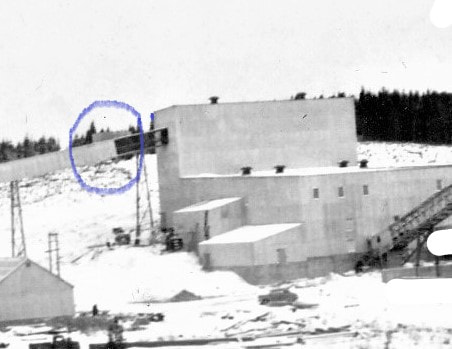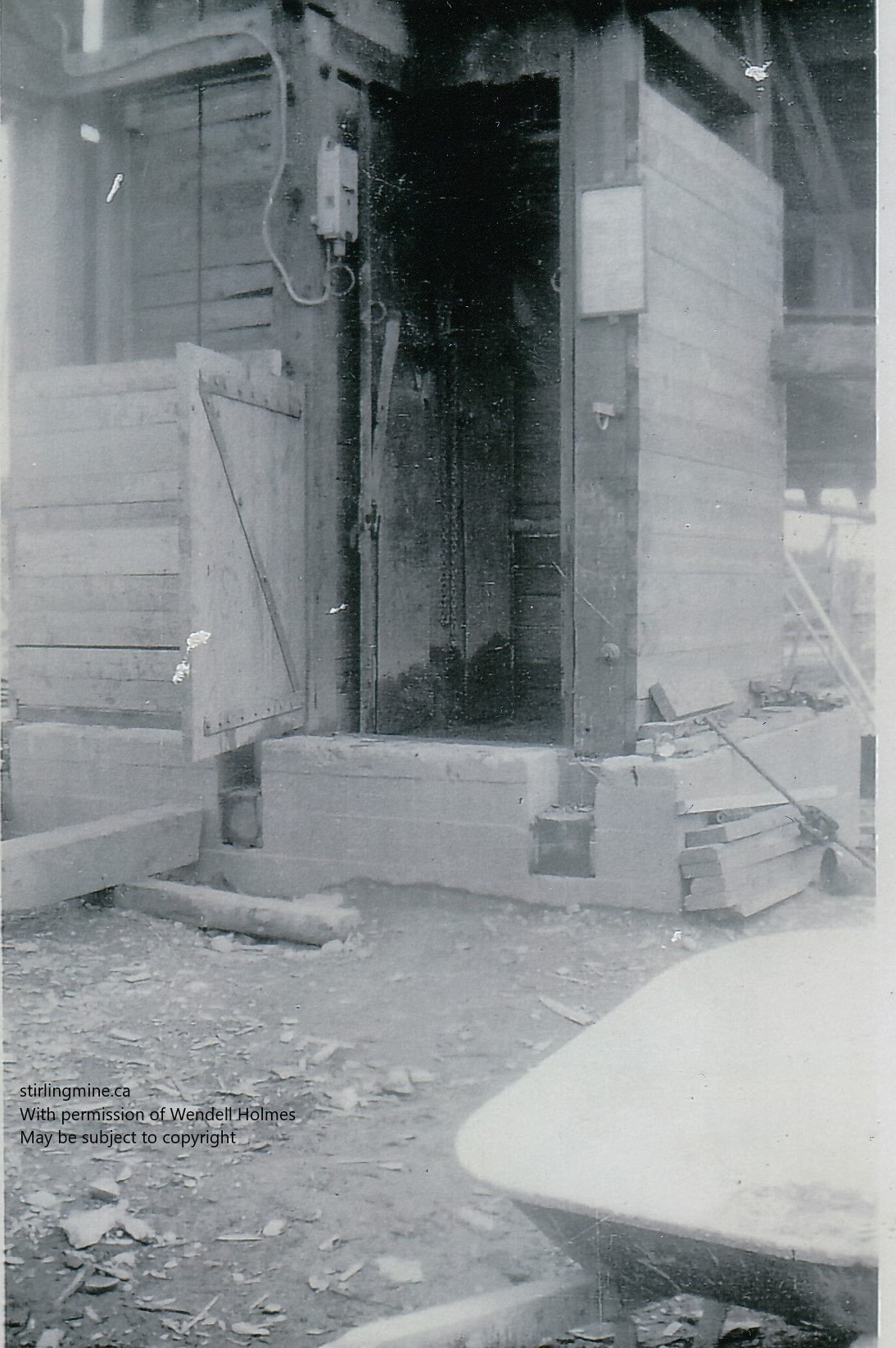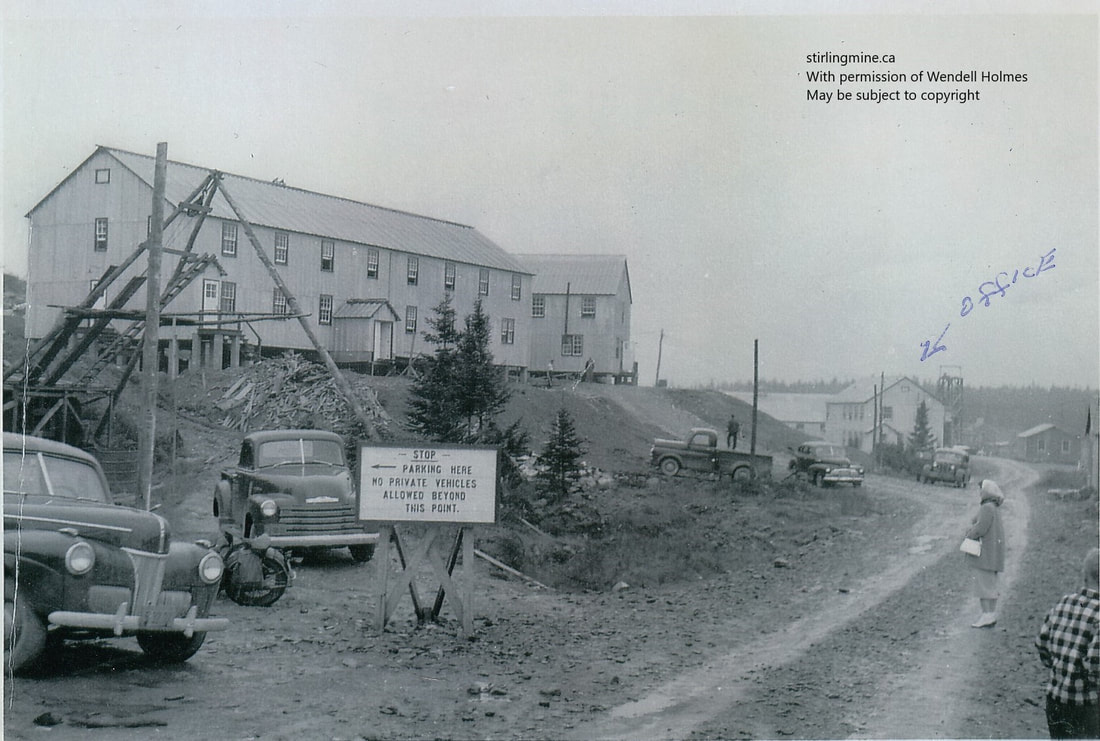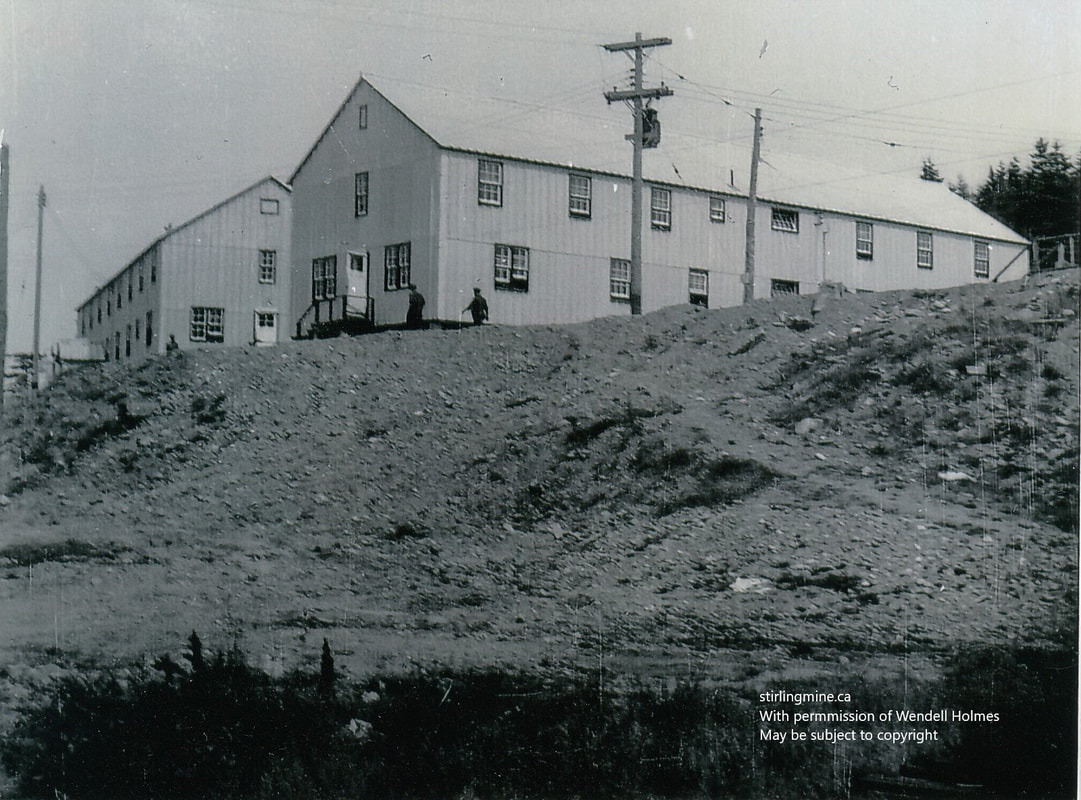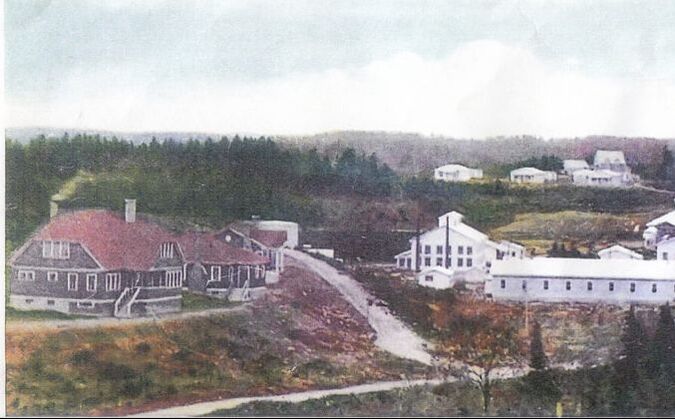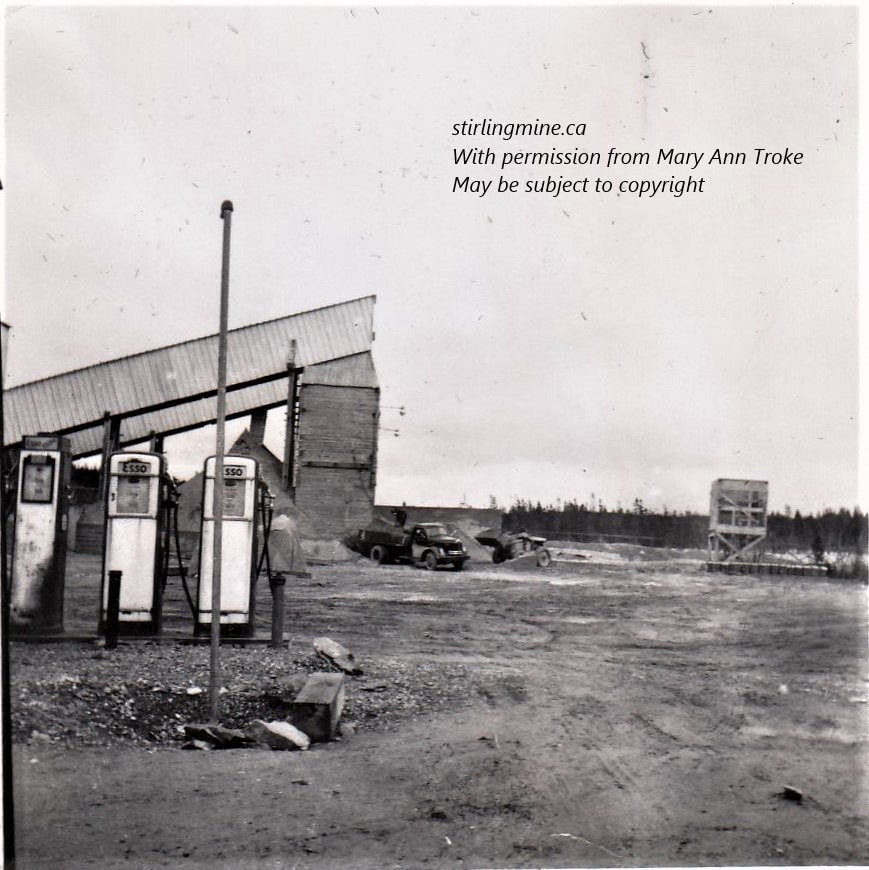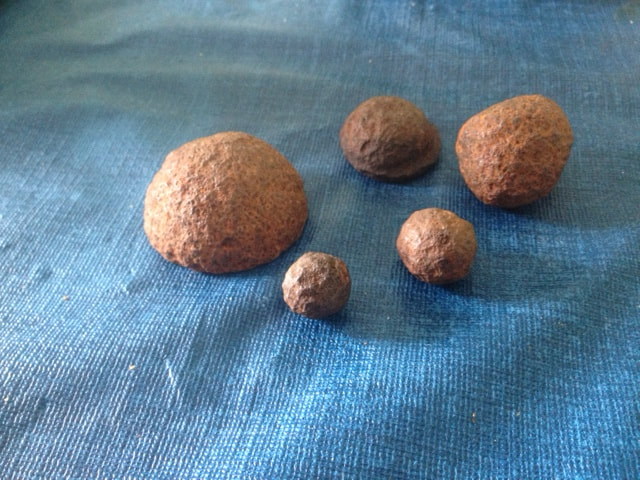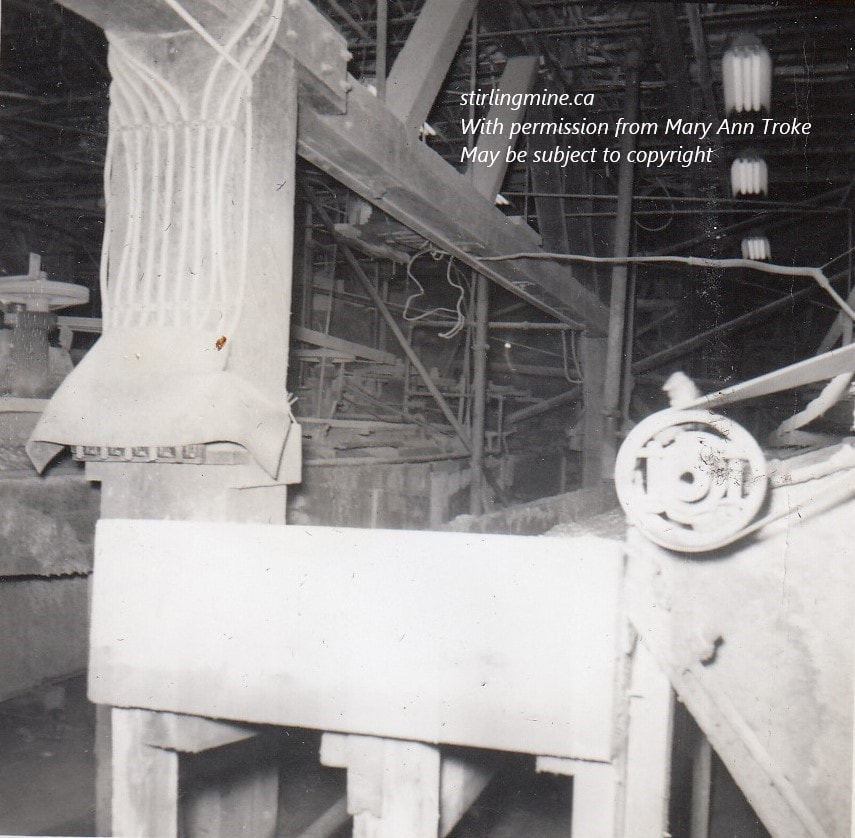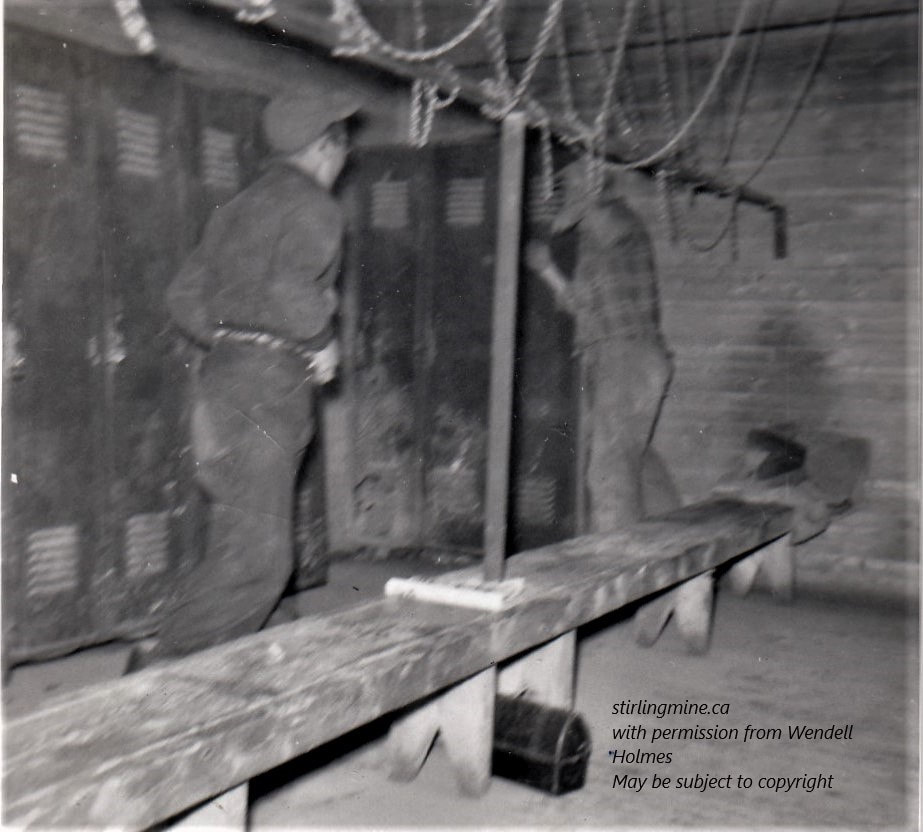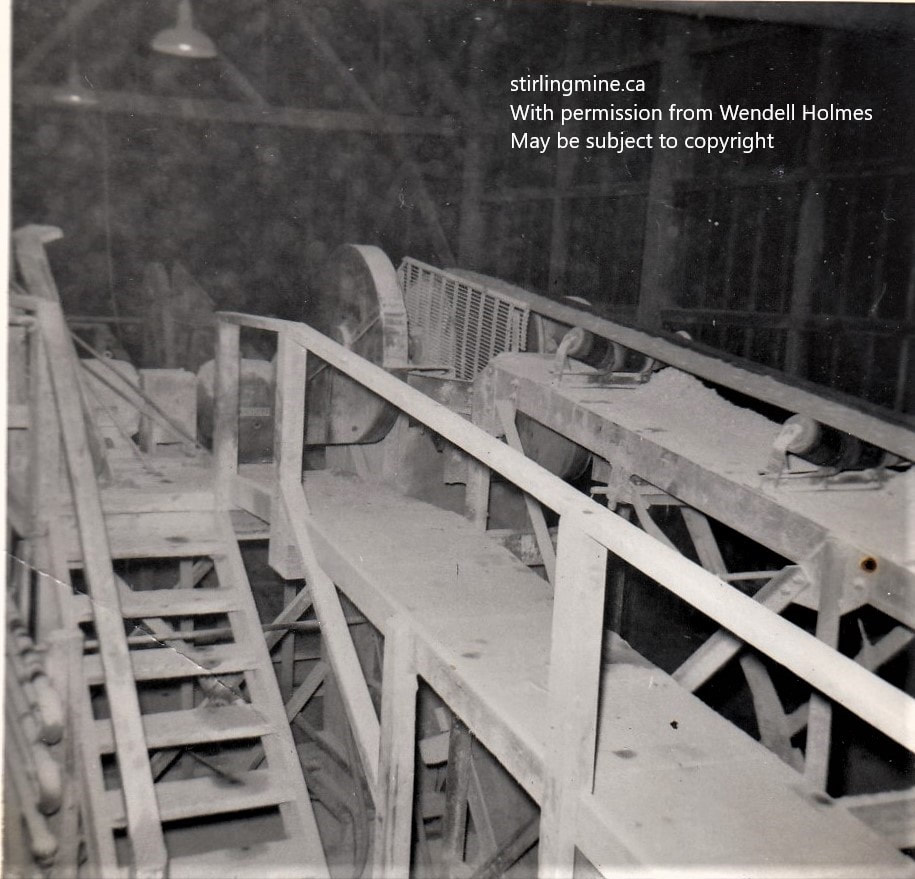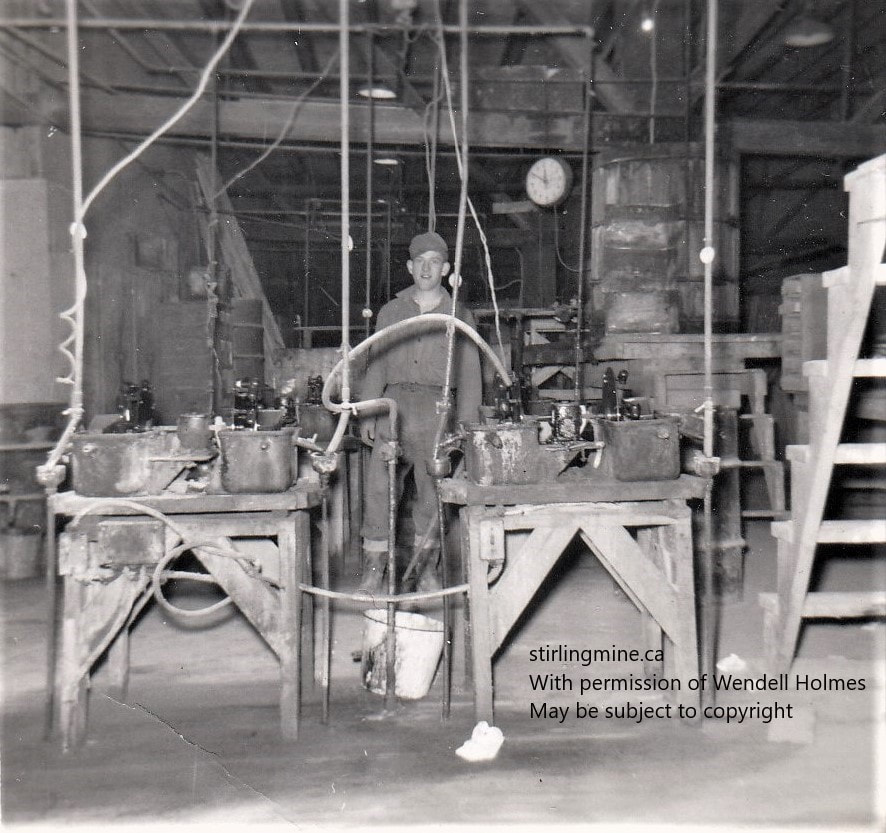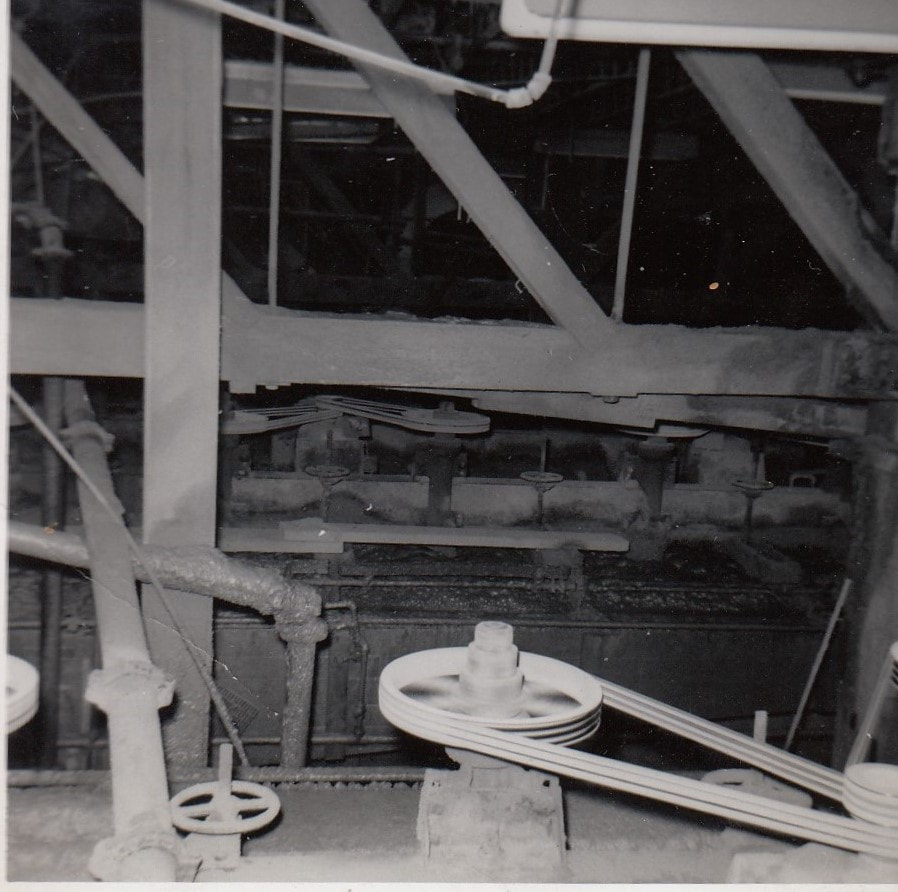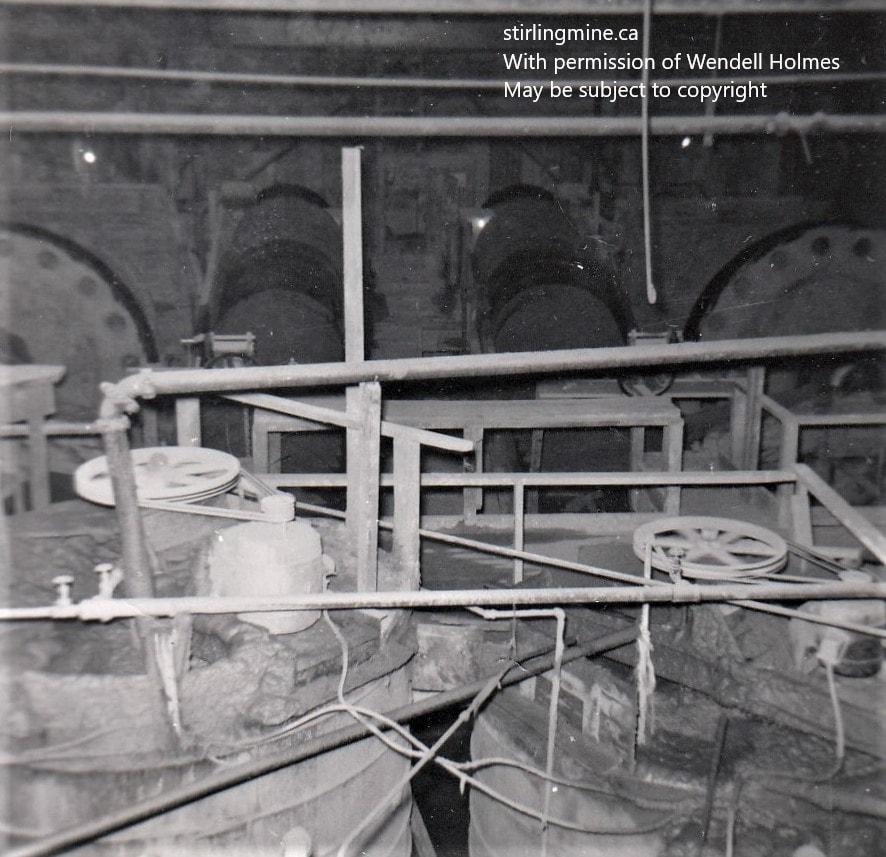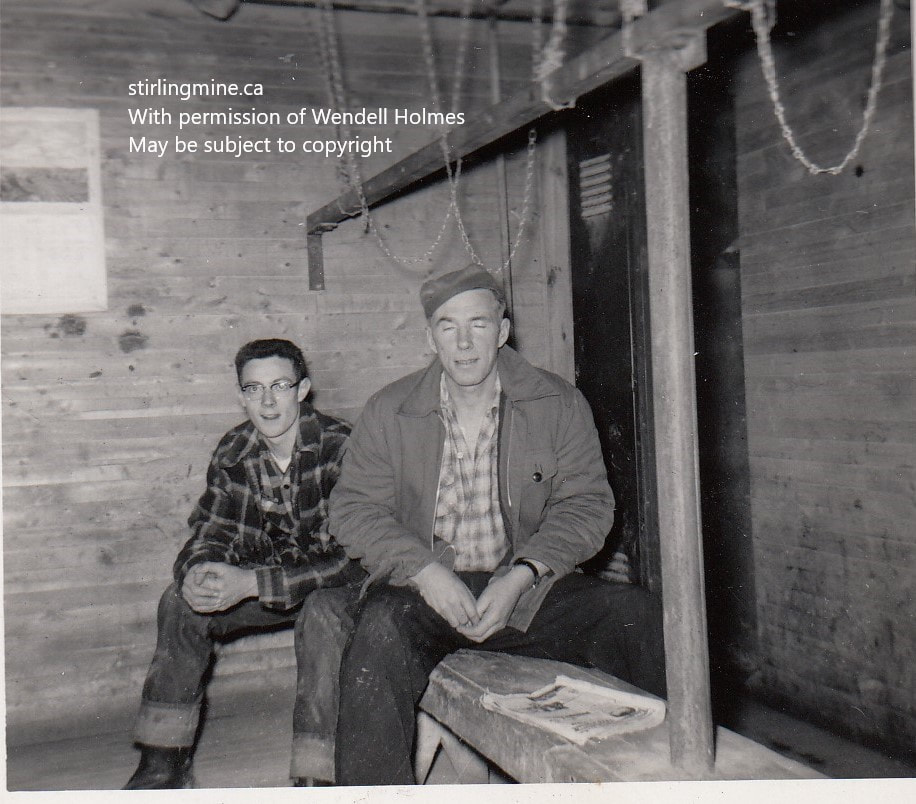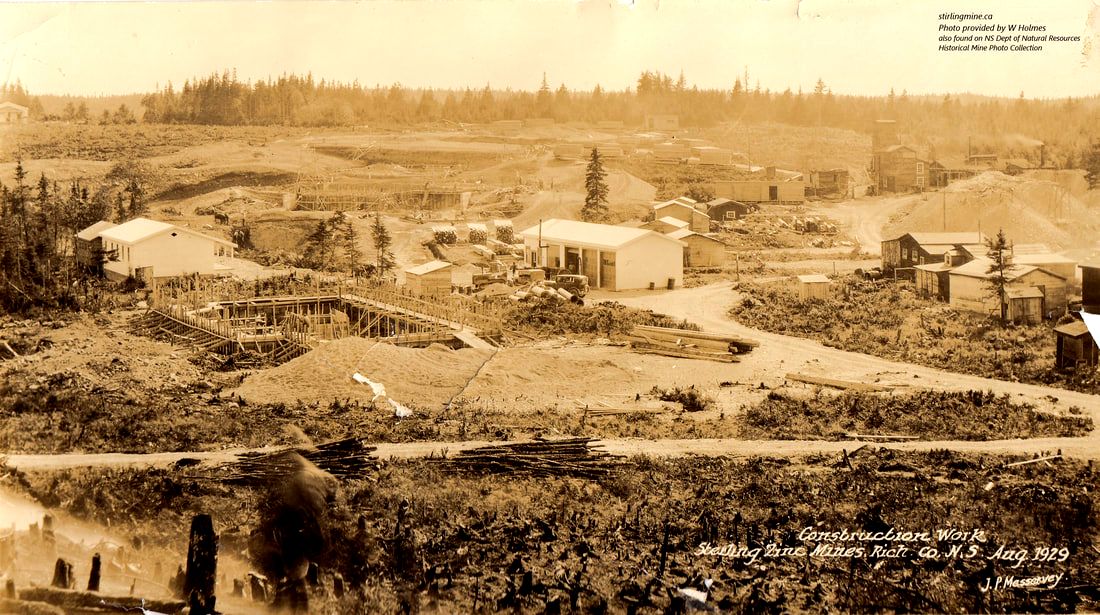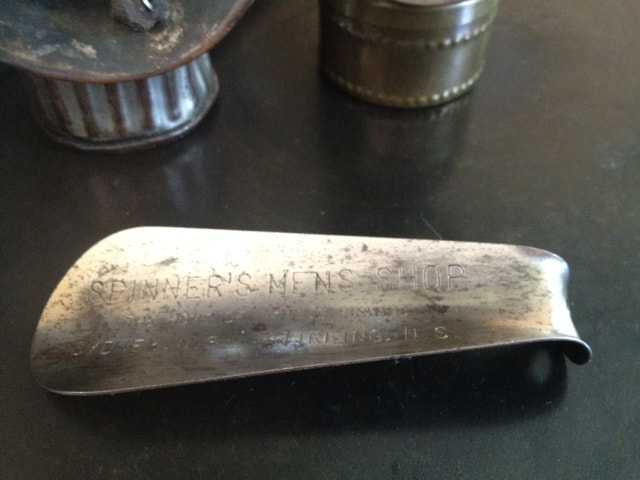Interview with Wendell Holmes, Grand River, Stirling Mine,
Photos of Headlamps owned by Wendell Holmes
Photos of Headlamps owned by Wendell Holmes
Wendell: I imagine they used them when it (the mine) was going in the 30’s and the 20’s).
Jeanette: That’s a lamp.
Wendell: Yeah, they were carbide.
Jeanette: How did they run, by a battery or…?
Wendell: No. I found this one in the muck (the tin colored lamp). This one (the brass colored lamp) is in good shape. I don’t remember where I found it.
Jeanette: Was that from Stirling?
Wendell: Yes. Stirling. They put Carbide in there (the bottom) and water in there (in the top).
Jeanette: So, Carbide in the bottom and water in the top.
Wendell: It’s in very good shape. I don’t think it was used much.
Jeanette: It’s very nice, in good shape.
Wendell: I guess the water came out there. You could adjust it. It was like a cigarette lighter. There was a flint and it would show a flame.
Jeanette: Oh, Is that how they would see (underground)?
Wendell: Yeah.
Jeanette: It was a flame.
Wendell: Yes, before batteries. I think they used these a little bit in early 51 in the old shaft. They were all electric after that.
Jeanette: In the early 50’s when they were using the old shaft they still used some of those (old lamps)!
Wendell: They must have because I remember people having them on when I went down there in 51, early 51.
Jeanette: That would have been dangerous, wouldn’t it?
Wendell: Not in a hard rock mine.
Jeanette: There would be no gas.
Wendell: No. I don’t know how they did that in the coal mine with the flame.
Jeanette: So how would they do that -the water would mix with the carbide?
Wendell: The water would mix with the carbide and it would make fumes or whatever. The flame would shoot out. I remember seeing them lit. I don’t know if they’d give much light, but they must have.
Jeanette: That’s amazing. And there was a little igniter there too.
Wendell: This one had a reflector on it.
Jeanette: That would be the older one (tin colored). You said you found it in the mud.
Wendell: Yes. I don’t remember where I picked it up. It was around the mine (Stirling) some place.
Jeanette: Wow
Wendell: It’s all beat up. It’s been used. I don’t know if this one was ever (used). I forget where I got that. It was at Stirling. I polished it up. It started to fade.
Jeanette: It looks like it is brass. The old one looks like it is tin.
Wendell: Yes. This one looks to be brass. I looked it up on the computer. It will tell (that it’s) patented 1901, 1912, 1913. It’s pretty old.
Jeanette: And this one here. (brass) does it say the patent on it too?
Wendell: It’s kind of hard to make out.
Jeanette: (Reading the writing on the lamp). Just Rite. Made in USA. LAPPLIDE.
Wendell: I know one day I typed that in (the computer); Everything came up about it. It showed the different types, and the history of the company.
Jeanette: That’s probably worth a few pennies.
Wendell: I don’t think. That’s what I was thinking that maybe they were worth something, but they weren’t worth that much.
Jeanette: It’s great to be able to have that.
(above)Jeanette: Now you have a piece of rock (above). Is that from the mine?
Wendell: It was a piece of the ore from there. It was the good stuff. I’d say that was pretty good. There was pyrite in it too. You can see the mineral in it. The darker stuff, that could be copper. It was copper, lead and Zinc that they took out.
Jeanette: It just looks like any old piece of rock.
Wendell: It is heavy. Can you feel how heavy it is?
Jeanette: (Lifts the rock). Yes, I didn’t realize it. It is very heavy. That is a small rock about 2”x 2” (square shaped). I’d say it weighs about 6 ounces.
Wendell: I’d say, anyway.
Jeanette: So, the rock, when it came up from the mine (underground), would it be in big chunks like a foot wide?
Wendell: I wasn’t underground but when it would come up to the crusher on the surface, it would be pretty big. It went into the big crusher then it went on a conveyer to the cone crusher and it made it smaller. It went into the big crusher first and then into the cone crusher. It was kind of round. Then we’d have trouble when the ore was wet which it often was. Sometimes it would be wet coming up. It would plug up. You’d have to get the air hose and the air line to clear it and then it went on a conveyer and it went over a screen – a shaker screen, I think. If it was too big for that it would go back to the cone crusher and what was fine went up the conveyor to the mill.
Jeanette: So, you were up on the other side of the big conveyor in the mill.
Wendell: Yeah. I did work a little bit in the crusher house, but not too much. I was mostly up in the mill.
Jeanette: So, the crusher house had two crushers. The rock might come in big chunks maybe 2 feet by 2 feet.
Wendell: Yes. It could be pretty big. It would go into the big crusher and when it came out of the big tank, I think you may be able to see in one of those pictures, there was a big chain hauling it down the shoot into the conveyor and it went into the big crusher and from there it went into the cone crusher.
Wendell: MacDougall there he is there at the crusher. There’s the crusher there. There’s where the ore came down out of one of the tanks. See the big chains that hauled it down and it came down on a conveyor belt and went into the big crusher. There’s the big crusher, the big jaw crusher.
Jeanette: Wow, there’s Mr. MacDougall there. Wow.
Wendell: He was from down Sydney Mines?
Wendell: It was a piece of the ore from there. It was the good stuff. I’d say that was pretty good. There was pyrite in it too. You can see the mineral in it. The darker stuff, that could be copper. It was copper, lead and Zinc that they took out.
Jeanette: It just looks like any old piece of rock.
Wendell: It is heavy. Can you feel how heavy it is?
Jeanette: (Lifts the rock). Yes, I didn’t realize it. It is very heavy. That is a small rock about 2”x 2” (square shaped). I’d say it weighs about 6 ounces.
Wendell: I’d say, anyway.
Jeanette: So, the rock, when it came up from the mine (underground), would it be in big chunks like a foot wide?
Wendell: I wasn’t underground but when it would come up to the crusher on the surface, it would be pretty big. It went into the big crusher then it went on a conveyer to the cone crusher and it made it smaller. It went into the big crusher first and then into the cone crusher. It was kind of round. Then we’d have trouble when the ore was wet which it often was. Sometimes it would be wet coming up. It would plug up. You’d have to get the air hose and the air line to clear it and then it went on a conveyer and it went over a screen – a shaker screen, I think. If it was too big for that it would go back to the cone crusher and what was fine went up the conveyor to the mill.
Jeanette: So, you were up on the other side of the big conveyor in the mill.
Wendell: Yeah. I did work a little bit in the crusher house, but not too much. I was mostly up in the mill.
Jeanette: So, the crusher house had two crushers. The rock might come in big chunks maybe 2 feet by 2 feet.
Wendell: Yes. It could be pretty big. It would go into the big crusher and when it came out of the big tank, I think you may be able to see in one of those pictures, there was a big chain hauling it down the shoot into the conveyor and it went into the big crusher and from there it went into the cone crusher.
Wendell: MacDougall there he is there at the crusher. There’s the crusher there. There’s where the ore came down out of one of the tanks. See the big chains that hauled it down and it came down on a conveyor belt and went into the big crusher. There’s the big crusher, the big jaw crusher.
Jeanette: Wow, there’s Mr. MacDougall there. Wow.
Wendell: He was from down Sydney Mines?
Jeanette. Why was it called a cone crusher?
Wendell: It was round, and it was like a cone.
Jeanette: So, it was wide on the top and narrow (at the bottom).
Wendell: And the stuff went in it - It was like a thing that shook and then it went down and around.
Jeanette: The first crusher, was it sort of like a press.
Wendell: No, it had jaws.
Jeanette: Oh, yes, the Jaw Crusher.
Wendell: It went bang, bang, bang, bang. It had a big wheel and an electric motor turning it. There was lots of dust and noise.
Jeanette: So, then when it went into the cone crusher…
Wendell: It made it smaller and then it went onto a screen and the screen was shaking and the small stuff went through and the big stuff went back into the cone crusher. What went into the cone crusher was about this size or bigger (Wendell demonstrates size with his hand).
Jeanette: So, about 1 ½ -2 inches then.
Wendell: Yes.
Jeanette Then after it’s sifted it goes up to the Mill.
Wendell: It would go up the big conveyor and those two big tanks. I think you can still see the base.
Jeanette: Yes, those two big disks. I call them “the disks” but they are the bases (see below).
Wendell: It was round, and it was like a cone.
Jeanette: So, it was wide on the top and narrow (at the bottom).
Wendell: And the stuff went in it - It was like a thing that shook and then it went down and around.
Jeanette: The first crusher, was it sort of like a press.
Wendell: No, it had jaws.
Jeanette: Oh, yes, the Jaw Crusher.
Wendell: It went bang, bang, bang, bang. It had a big wheel and an electric motor turning it. There was lots of dust and noise.
Jeanette: So, then when it went into the cone crusher…
Wendell: It made it smaller and then it went onto a screen and the screen was shaking and the small stuff went through and the big stuff went back into the cone crusher. What went into the cone crusher was about this size or bigger (Wendell demonstrates size with his hand).
Jeanette: So, about 1 ½ -2 inches then.
Wendell: Yes.
Jeanette Then after it’s sifted it goes up to the Mill.
Wendell: It would go up the big conveyor and those two big tanks. I think you can still see the base.
Jeanette: Yes, those two big disks. I call them “the disks” but they are the bases (see below).
Wendell: Yes, well it would go in there. There would be someone on top of the conveyor. I had to work there for a while and when one tank got full you would put a shoot in and put it down another little conveyor and it went in the other tank. They were high tanks. In the bottom of those were the feeders that took the crushed rock out and went to the ball mills.
Jeanette: So, when they went into those tanks, was there water in it?
Wendell: No, not in the tank. The dryer it was the better.
Jeanette: What was the purpose of the tanks?
Wendell: Just to store it. There would be tons and tons of it. Usually, you’d run out, say if there was trouble in the crusher house. We’d run out of ore.
Jeanette: There’d be nothing in there.
Wendell: We’d have to shut the ball mill down. There was a little conveyer under each tank, and it brought the crushed rock out to each ball mill.
Jeanette: So, it went up the conveyor belt into those tanks for storage and the bottom part – there’s ...
Wendell: A shoot coming out.
Jeanette: And then it would allow so much to come out (at a time)?
Wendell: Into the ball mills.
Jeanette: Would there be more than one ball mill?
Wendell: There were two big ones and a smaller one. When it was all ground up in the ball mill, it was like a soup then. It came out though the overflow to the classifiers, I think they were called. And then they’d go into tanks again, but it was just what they put in the Floatations, which floated the stuff.
Jeanette: So, after the ball mill, it went into floatation tanks.
Wendell: Yes. They were like big eggbeaters. They had motors and they turned. The chemicals made a foam and these paddles took off the foam. The foam – it was the concentrate.
Jeanette: So, the foam was whatever came to the top and that paddle flipped it over to some other kind of container? Note see picture of floatations below.
Jeanette: So, when they went into those tanks, was there water in it?
Wendell: No, not in the tank. The dryer it was the better.
Jeanette: What was the purpose of the tanks?
Wendell: Just to store it. There would be tons and tons of it. Usually, you’d run out, say if there was trouble in the crusher house. We’d run out of ore.
Jeanette: There’d be nothing in there.
Wendell: We’d have to shut the ball mill down. There was a little conveyer under each tank, and it brought the crushed rock out to each ball mill.
Jeanette: So, it went up the conveyor belt into those tanks for storage and the bottom part – there’s ...
Wendell: A shoot coming out.
Jeanette: And then it would allow so much to come out (at a time)?
Wendell: Into the ball mills.
Jeanette: Would there be more than one ball mill?
Wendell: There were two big ones and a smaller one. When it was all ground up in the ball mill, it was like a soup then. It came out though the overflow to the classifiers, I think they were called. And then they’d go into tanks again, but it was just what they put in the Floatations, which floated the stuff.
Jeanette: So, after the ball mill, it went into floatation tanks.
Wendell: Yes. They were like big eggbeaters. They had motors and they turned. The chemicals made a foam and these paddles took off the foam. The foam – it was the concentrate.
Jeanette: So, the foam was whatever came to the top and that paddle flipped it over to some other kind of container? Note see picture of floatations below.
Wendell: Yes, and it went into another tank and it went through the filter and it was just like sand and then it went out to where it was hauled to St Peter’s.
Jeanette: When it was hauled to St Peter’s, one load would be …
Wendell: One would be Zinc and the other would be Lead and copper (together).
Jeanette: So, they never separated that out (the lead and the Copper). It was just the Zinc that was separated.
So, the other two were still mixed together when they left?
Wendell: Yes.
Wendell: After it was shipped to St Peter’s, it went out by rail. I don’t know where it went then, some smelter I guess. (See Baillie McCrea’s note to Don Strachan re where the ore went).
Jeanette: I think it went to the states and Britain too.
Wendell: Could be. When the mine went in the 30’s, it likely went oversees, anyway. It was shipped from Fourchu in the 30’s.
Jeanette: Yes. That mine muck -that happened in the 30’s.
Wendell: That waste - In the 50’s too.
Jeanette: They put a retaining wall there (in the 50’s)
Wendell: They had a wall there, Yes.
Wendell: There was a lot of it that was still good. They talked one time about doing it over again.
Jeanette: They had a settling pond so that the water going into that little brook (Strachan’s) wouldn’t be taking that sediment with it. They did a little project (in 1996 to remedy this) because it wasn’t really working very well, it was still going into that little brook.
Jeanette: When it was hauled to St Peter’s, one load would be …
Wendell: One would be Zinc and the other would be Lead and copper (together).
Jeanette: So, they never separated that out (the lead and the Copper). It was just the Zinc that was separated.
So, the other two were still mixed together when they left?
Wendell: Yes.
Wendell: After it was shipped to St Peter’s, it went out by rail. I don’t know where it went then, some smelter I guess. (See Baillie McCrea’s note to Don Strachan re where the ore went).
Jeanette: I think it went to the states and Britain too.
Wendell: Could be. When the mine went in the 30’s, it likely went oversees, anyway. It was shipped from Fourchu in the 30’s.
Jeanette: Yes. That mine muck -that happened in the 30’s.
Wendell: That waste - In the 50’s too.
Jeanette: They put a retaining wall there (in the 50’s)
Wendell: They had a wall there, Yes.
Wendell: There was a lot of it that was still good. They talked one time about doing it over again.
Jeanette: They had a settling pond so that the water going into that little brook (Strachan’s) wouldn’t be taking that sediment with it. They did a little project (in 1996 to remedy this) because it wasn’t really working very well, it was still going into that little brook.
Wendell: It was pretty potent stuff. It killed all the trees but then a few trees have started to grow back.
Jeanette: Yes, finally it is starting to grow now. When my son was young, he is 35 now, we skated there at the mine muck on the barren road. It killed all the tress down there too. When that little river would flood, we would go skating there.
Wendell: It carried right through and even went down the turn where the Taylor’s used to live there. Harry Taylor. You can still see some of it there – not on the barren road but on the other road.
Jeanette: Oh, the Stirling Rd going into where the hall is (in Framboise).
Wendell: Yeah. You still see a little of it there.
Jeanette: Well the river goes down there where Clausen's used to live.
Wendell: Yeah
Jeanette: It goes down there and then into the Framboise River. They call that Strachan’s Brook. I think it may come from the MacLean’s Lake and then down through the mine.
Wendell: It was quite the thing in the day.
Jeanette: Yes, yes.
Working for Roddie
Jeanette: So, you worked at the mill and you did a little work at the crusher – the Jaw Crusher- for a little while.
Wendell: First, I started working for Roddy MacLeod, Roddie John Alex. He was the labour foreman. There was Roddy MacLeod and John Cameron. He was foreman too, for pouring cement. After the mine went into production, I think Roddie was Millwright. He worked around the Mill as a mechanic. John Cameron was working in the crusher house after the Mill went into production and then Charlie Hardy was the foreman.
Jeanette: So, construction as in foundations and cement work and stuff like that?
Wendell: Yeah, well getting all this cement poured there and everything and putting up the buildings. I would say, when I went there I worked with Roddie and the Labour gang maybe in 52. In the summer of 52 I went to the Mill. Right about then it was just starting up.
Jeanette: It would have taken a while to get it all built up.
Wendell: Yeah
Jeanette: So, Roddy. He lived up on the Soldier’s Cove/Lewis Cove Road?
Wendell: He was originally from up the Frank MacDonald Rd and then he lived over the Lewis Cove Rd. and John Cameron did too.
Jeanette: So, John Cameron
Wendell: He’d be Glendon’s father.
Jeanette: So, they were Carpenter’s were they?
Wendell: Roddie was a carpenter originally but then when they started construction at the mine, he was foreman, pick and shovel, anything that was labour around the (mine site).
Jeanette: Angus MacLeod, John James brother. He said he worked for Roddie MacLeod too
Wendell: That’s right.
Jeanette: They were building some small buildings, like sheds.
Wendell: Yeah
Jeanette: And I’m thinking they are the ones on the other side of the conveyor belt.
Wendell: Could be, yeah.
Jeanette: He worked with him (Roddie) for a while and I guess there wasn’t enough work there and he went underground.
Wendell: Yeah, I know in the end, Hardy, after the mine was in production, he was a surface foreman or a labour foreman.
Jeanette: So, any buildings that needed to be built or any form work or anything like that
Wendell: I imagine he had something to do with that. There were bosses over him too.
Jeanette: My father (Soutter) did some carpentry work there. He was a foreman there.
Wendell: He was with the carpenters.
Jeanette: Do you remember what he’d be doing?. Would he be building those buildings, the wooden structures?
Wendell: Yeah, yeah.
Wendell: And the houses on the left
Jeanette: Three, I believe, that’s the general consensus.
Wendell: And there were more up behind John G’s, maybe 5 or 6.
Jeanette: Well Bill MacLeod (Grand River) said there were 17 there.
Wendell: Could be.
Jeanette: There’s a pile of foundations up there.
Jeanette: I tracked 6 or 7 of those houses (behind John G’s)
Wendell: Yeah. And the road went in just beyond the Chinese restaurant and it went up around the hill. I was never around there very much but I know there were houses up there.
Jeanette: Across from the Chinese restaurant there was, I think it was, an old bunkhouse.
Wendell: Yeah. It was a bunkhouse.
Jeanette: They used it for a theatre.
Wendell: Yeah. They used to have shows in there.
Jeanette: Did you ever go to any.
Wendell: Yeah.
Jeanette: Do you remember the name of it?
Wendell: No. I can’t remember. I think they had a pool table in there too. I’m not sure of that.
Jeanette: They had a recreation center, apparently.
Wendell: Yes, a dance hall up on the hill. Up back of where the old mill was. After you’d pass the old shaft, you’d go a little to your left.
Jeanette: Where was the old shaft in comparison to the Glory Hole.
Wendell: It was just beyond the Glory hole. Not far from the Glory hole.
Jeanette: In one of the pictures I have, there are some house /buildings kind of far to the left. Would that be (where the hall was)
Jeanette: Yes, finally it is starting to grow now. When my son was young, he is 35 now, we skated there at the mine muck on the barren road. It killed all the tress down there too. When that little river would flood, we would go skating there.
Wendell: It carried right through and even went down the turn where the Taylor’s used to live there. Harry Taylor. You can still see some of it there – not on the barren road but on the other road.
Jeanette: Oh, the Stirling Rd going into where the hall is (in Framboise).
Wendell: Yeah. You still see a little of it there.
Jeanette: Well the river goes down there where Clausen's used to live.
Wendell: Yeah
Jeanette: It goes down there and then into the Framboise River. They call that Strachan’s Brook. I think it may come from the MacLean’s Lake and then down through the mine.
Wendell: It was quite the thing in the day.
Jeanette: Yes, yes.
Working for Roddie
Jeanette: So, you worked at the mill and you did a little work at the crusher – the Jaw Crusher- for a little while.
Wendell: First, I started working for Roddy MacLeod, Roddie John Alex. He was the labour foreman. There was Roddy MacLeod and John Cameron. He was foreman too, for pouring cement. After the mine went into production, I think Roddie was Millwright. He worked around the Mill as a mechanic. John Cameron was working in the crusher house after the Mill went into production and then Charlie Hardy was the foreman.
Jeanette: So, construction as in foundations and cement work and stuff like that?
Wendell: Yeah, well getting all this cement poured there and everything and putting up the buildings. I would say, when I went there I worked with Roddie and the Labour gang maybe in 52. In the summer of 52 I went to the Mill. Right about then it was just starting up.
Jeanette: It would have taken a while to get it all built up.
Wendell: Yeah
Jeanette: So, Roddy. He lived up on the Soldier’s Cove/Lewis Cove Road?
Wendell: He was originally from up the Frank MacDonald Rd and then he lived over the Lewis Cove Rd. and John Cameron did too.
Jeanette: So, John Cameron
Wendell: He’d be Glendon’s father.
Jeanette: So, they were Carpenter’s were they?
Wendell: Roddie was a carpenter originally but then when they started construction at the mine, he was foreman, pick and shovel, anything that was labour around the (mine site).
Jeanette: Angus MacLeod, John James brother. He said he worked for Roddie MacLeod too
Wendell: That’s right.
Jeanette: They were building some small buildings, like sheds.
Wendell: Yeah
Jeanette: And I’m thinking they are the ones on the other side of the conveyor belt.
Wendell: Could be, yeah.
Jeanette: He worked with him (Roddie) for a while and I guess there wasn’t enough work there and he went underground.
Wendell: Yeah, I know in the end, Hardy, after the mine was in production, he was a surface foreman or a labour foreman.
Jeanette: So, any buildings that needed to be built or any form work or anything like that
Wendell: I imagine he had something to do with that. There were bosses over him too.
Jeanette: My father (Soutter) did some carpentry work there. He was a foreman there.
Wendell: He was with the carpenters.
Jeanette: Do you remember what he’d be doing?. Would he be building those buildings, the wooden structures?
Wendell: Yeah, yeah.
Wendell: And the houses on the left
Jeanette: Three, I believe, that’s the general consensus.
Wendell: And there were more up behind John G’s, maybe 5 or 6.
Jeanette: Well Bill MacLeod (Grand River) said there were 17 there.
Wendell: Could be.
Jeanette: There’s a pile of foundations up there.
Jeanette: I tracked 6 or 7 of those houses (behind John G’s)
Wendell: Yeah. And the road went in just beyond the Chinese restaurant and it went up around the hill. I was never around there very much but I know there were houses up there.
Jeanette: Across from the Chinese restaurant there was, I think it was, an old bunkhouse.
Wendell: Yeah. It was a bunkhouse.
Jeanette: They used it for a theatre.
Wendell: Yeah. They used to have shows in there.
Jeanette: Did you ever go to any.
Wendell: Yeah.
Jeanette: Do you remember the name of it?
Wendell: No. I can’t remember. I think they had a pool table in there too. I’m not sure of that.
Jeanette: They had a recreation center, apparently.
Wendell: Yes, a dance hall up on the hill. Up back of where the old mill was. After you’d pass the old shaft, you’d go a little to your left.
Jeanette: Where was the old shaft in comparison to the Glory Hole.
Wendell: It was just beyond the Glory hole. Not far from the Glory hole.
Jeanette: In one of the pictures I have, there are some house /buildings kind of far to the left. Would that be (where the hall was)
|
Wendell: (the 50’s mine site) The dance hall was up there (to the left). There were other buildings up there, too. I don’t think there were any houses there. I don’t know.
Jeanette: It’s hard to make out. Wendell: The old shaft would be up here (to the right), and the road would go up like that, I think. There are two buildings there that are a pretty good size. I know the hall was up there. I remember being at a dance up there. Jeanette: OK, so that’s up on the left-hand side. Wendell: There’s a few buildings. Jeanette: This is a different angle. It looks like it (the picture) was taken from behind John G’s there. |
Jeanette: Is that the old shaft? See photo above
Wendell: That’s the old shaft. It looks like maybe it could have been taken when they were tearing it down or something. It looks like it wasn’t used much. The hoist was in there (the white building). That would be at the old shaft.
Jeanette: Would that be a dry house (white building)?
Wendell: Not over there. That would have been - See the hoist house was in there. What else was in there.? Oh yes, what was in there too, was the generators before the power came. The power came through in 52 I guess. Before the power came, there were big generators in there.
Jeanette: Which ran the whole shebang (mine). That’s amazing.Wendell: There’s the part of the old shaft (above)
Wendell: It looks like it could be Angus Archie.
Jeanette: The man standing?
Wendell: Yeah
Jeanette: And the other guy, it’s hard to tell.
Wendell: Yes, it’s hard to tell.
Jeanette: That’s pretty well what everybody thought that it was Angus. Just the way he stands.
Wendell: That’s the old shaft. It looks like maybe it could have been taken when they were tearing it down or something. It looks like it wasn’t used much. The hoist was in there (the white building). That would be at the old shaft.
Jeanette: Would that be a dry house (white building)?
Wendell: Not over there. That would have been - See the hoist house was in there. What else was in there.? Oh yes, what was in there too, was the generators before the power came. The power came through in 52 I guess. Before the power came, there were big generators in there.
Jeanette: Which ran the whole shebang (mine). That’s amazing.Wendell: There’s the part of the old shaft (above)
Wendell: It looks like it could be Angus Archie.
Jeanette: The man standing?
Wendell: Yeah
Jeanette: And the other guy, it’s hard to tell.
Wendell: Yes, it’s hard to tell.
Jeanette: That’s pretty well what everybody thought that it was Angus. Just the way he stands.
Jeanette See that structure there (photo above). That’s the old shaft (again).
Wendell: Yes, that’s the old shaft. That’s the shaft house (white building in background). The generators were in there.
Wendell: That’s the conveyor belt going up. There were buildings here (in background). I remember there was a cement shed. The road went down here by where they used to store the cement. The lab, the assay office, they called it, where they did the testing, was over to this side (left). The dry for the old shaft may have been in one of those buildings (next to the Assay office).
Jeanette: So, these buildings here they are in another picture (below).
Wendell: Yes, that’s the old shaft. That’s the shaft house (white building in background). The generators were in there.
Wendell: That’s the conveyor belt going up. There were buildings here (in background). I remember there was a cement shed. The road went down here by where they used to store the cement. The lab, the assay office, they called it, where they did the testing, was over to this side (left). The dry for the old shaft may have been in one of those buildings (next to the Assay office).
Jeanette: So, these buildings here they are in another picture (below).
Jeanette: these are the buildings that you can see here.
Wendell: And maybe sometime later these were torn down.
Wendell: The road went down by here.
Jeanette: I think it’s a little clearer here. So, it went on the other side of the conveyor and then went down by those little buildings.
Jeanette: Was there a core sample house.
Wendell: That could have been it. See, I know there was a building full of the drilling cores.
Jeanette: It might be one of those little buildings there.
Jeanette: This is the mill (background right). This is when it was under construction right?
Wendell: Either under construction or when they were tearing it down. It looks like it was under construction there because that wasn’t there - that silo. That could be one of Malcolm MacDonald’s trucks. Billy man used to be on the machine that loaded the trucks.
Jeanette: So, he was on the loader, Billy Mann.
Wendell: Yeah, that’s likely when they were building. That building there (the white building the left was the assay office, is what they called it. This was the old cement shed here. This would have been the core. I’m just taking a guess.
Jeanette: I think there was a scale there too.
Wendell: There was a scale there someplace. I know years ago there was a thing there where we used to drive our cars up on it. We used to change our oil there. They used to say it was where the old scale was when the mine went in the 30’s. I would say there was a scale there when it went in the 50’s too. I kind of don’t remember a scale there in the 50’s.
Jeanette: I asked Murdock (Morrison) and I’m sure he said it was weighed there In Stirling, they weighed it there (See Murdock Morrison’s interview for details).
Wendell: There must have been a scale. They must have had to weigh them because they wouldn’t want to be overweight if they got on the road.
.
Wendell: That’s the dry (above forefront).
Jeanette: This building is the dry! Yes, because Elmer MacGillivary said that when they got out from underground they went across the road.
Wendell: Yes. Calvin Hastings and Malcolm (MacLeod) were the lamp men in there. I don’t know if there was anyone else. Somebody else must have worked in there too but they looked after the lamps. They would charge them, put them on chargers.
Jeanette: In the dry house?
Wendell: Part of the dry house was for charging the lamps.
Wendell: Yes, the road went down ... and these are the tanks where the ore went in, where the skip came up and they dumped those two tanks before it went into the big crusher.
Jeanette: Oh, but I don’t think you see them in any other pictures. So that’s where the ore went.
Wendell: See they were just building the head frame there.
Jeanette: The shaft house, would they (the tanks) be enclosed in that.
Wendell: It was enclosed, yes, enclosed in the shaft house. The other building would be the crusher house.
Jeanette: Then there’s the hoist house somewhere down here.
Wendell: That’s it there (to the right of the tanks.
Jeanette: This building is the dry! Yes, because Elmer MacGillivary said that when they got out from underground they went across the road.
Wendell: Yes. Calvin Hastings and Malcolm (MacLeod) were the lamp men in there. I don’t know if there was anyone else. Somebody else must have worked in there too but they looked after the lamps. They would charge them, put them on chargers.
Jeanette: In the dry house?
Wendell: Part of the dry house was for charging the lamps.
Wendell: Yes, the road went down ... and these are the tanks where the ore went in, where the skip came up and they dumped those two tanks before it went into the big crusher.
Jeanette: Oh, but I don’t think you see them in any other pictures. So that’s where the ore went.
Wendell: See they were just building the head frame there.
Jeanette: The shaft house, would they (the tanks) be enclosed in that.
Wendell: It was enclosed, yes, enclosed in the shaft house. The other building would be the crusher house.
Jeanette: Then there’s the hoist house somewhere down here.
Wendell: That’s it there (to the right of the tanks.
Jeanette: There’s another picture that shows the hoist house - a better view of it (above).
Wendell: Yes, that’s the hoist house there.
Jeanette: And this is where they….
Wendell: Got the power, made the steam.
Jeanette: The boiler house..
Wendell: And this is the office (foreground building to the right).
Jeanette: There is a little building here across from the office. It doesn't seem to be in the other pictures.
Wendell: I think a lot of them were torn down afterwards. I think they were here during the construction,
Wendell: I don’t remember what that building was. It wasn’t a bunkhouse, that close to the mine I don’t think. See the steps there - that was the end of the cookhouse.
Jeanette: There’s the cookhouse there, right.
Wendell: And this is the warehouse and over next (to the left not shown) is the machine shop.
Jeanette: So, this is the warehouse there.
Wendell: that’s the warehouse, that’s the hoist house (with the shed roof).
Wendell: Alex MacDonnell’s brother was a hoist man.
Wendell: He lived in St Peters. He is dead now.
Jeanette: Alex and Archie.
Wendell: it could have been Archie his brother. Alex worked there too but I think he worked around the timbering and stuff.
Jeanette: So, Alex MacDonnell. They came from Mabou or some place like that.
Wendell: yeah over Mabou or Judique that area.
Jeanette: So then, he settled in St Peter’s.
Wendell: He settled in St Peter’s. That Archie got killed after that, some place in Ontario or Quebec.
Jeanette: Oh, in the mines?
Wendell: Yeah.
Jeanette: I was trying to find out what a Hoister did. When the guys would be down in the mine and I was talking to Elmer and Angus Alex, they were on the motor, the rig that took the ore from the shoots
Wendell: Down underground do you mean?
Jeanette: Yes
Wendell: Maybe on the motors, the select motors towing the cars. When they loaded it, they’d take it out where they dumped it into the ore shoot.
Jeanette: So, there was an ore shoot and they dropped it down there?
Wendell: Yeah
Jeanette: And the Hoisters is that when they’d take over down the bottom there.
Wendell: No, there would be big electric motors and drums that the cable was on. Everything was in this building here. The shaft was - there were two compartments -one for the cage and one for the skip to take the ore. The other was a cage to go up and down.
Jeanette: For the men
Wendell: Yeah
Jeanette: So, it was on one system. The cage would be…?
Wendell: for them to go down to work in the cage
Jeanette: And then the ore would be coming up on a hoist system next to it
Wendell: They’d be counterbalanced. One would come up and one would go down.
Jeanette: So, you’d be going down to work...
Wendell: And maybe the skip would be going up
Wendell: Maybe they put a skip on the bottom of the cage too when they were just skipping. I don’t know. I was up in the mill.
Jeanette: What was the skip anyways?
Wendell: It just held the ore, you know, taking it up.
Jeanette: So, the hoister, they worked down in the mine?
Wendell: No, not the Hoisters. They had a thing with every level marked on it. They had levers and everything and they pulled, and they watched. They knew just where that needle/ pointer stopped what level they were on.
Wendell: I was kind of fascinated watching them. When we’d be working around there. They’d be pulling all these signals. Beep, beep. beep. The person at the station would give the signal to the hoister. He’d know where they were at. They’d have it all signaled.
Wendell: There was something happened there (on the cage). Johnny MacLeod - Ian MacLeod was on the cage and Danny Burns and I don’t know who else.
Wendell: They were in the cage going down and something happened. Something hooked on the tracks going out the door and it started slamming in on them. I don’t know if they got her stopped or not. They got quite a scare I guess. I don’t know if they got hurt.
Jeanette: Oh
Wendell: I remember Ian talking about that. He and Danny Burns. I don’t know who else was on with them. They were on their way down to work I guess.
Jeanette: It must have hit up against something.
Wendell: Something sticking out or something that hooked on the way down and it damaged the door.
Jeanette: They probably would have been squashed
Wendell: I don’t know. They were probably able to stop the cage or something.
Jeanette: So, Ian worked underground?
Wendell: Yeah. I don’t know if he worked there very long. There were a lot of people coming and going. He worked there for a while, Ian. After that he worked in Sudbury for a while.
Wendell: Yes, that’s the hoist house there.
Jeanette: And this is where they….
Wendell: Got the power, made the steam.
Jeanette: The boiler house..
Wendell: And this is the office (foreground building to the right).
Jeanette: There is a little building here across from the office. It doesn't seem to be in the other pictures.
Wendell: I think a lot of them were torn down afterwards. I think they were here during the construction,
Wendell: I don’t remember what that building was. It wasn’t a bunkhouse, that close to the mine I don’t think. See the steps there - that was the end of the cookhouse.
Jeanette: There’s the cookhouse there, right.
Wendell: And this is the warehouse and over next (to the left not shown) is the machine shop.
Jeanette: So, this is the warehouse there.
Wendell: that’s the warehouse, that’s the hoist house (with the shed roof).
Wendell: Alex MacDonnell’s brother was a hoist man.
Wendell: He lived in St Peters. He is dead now.
Jeanette: Alex and Archie.
Wendell: it could have been Archie his brother. Alex worked there too but I think he worked around the timbering and stuff.
Jeanette: So, Alex MacDonnell. They came from Mabou or some place like that.
Wendell: yeah over Mabou or Judique that area.
Jeanette: So then, he settled in St Peter’s.
Wendell: He settled in St Peter’s. That Archie got killed after that, some place in Ontario or Quebec.
Jeanette: Oh, in the mines?
Wendell: Yeah.
Jeanette: I was trying to find out what a Hoister did. When the guys would be down in the mine and I was talking to Elmer and Angus Alex, they were on the motor, the rig that took the ore from the shoots
Wendell: Down underground do you mean?
Jeanette: Yes
Wendell: Maybe on the motors, the select motors towing the cars. When they loaded it, they’d take it out where they dumped it into the ore shoot.
Jeanette: So, there was an ore shoot and they dropped it down there?
Wendell: Yeah
Jeanette: And the Hoisters is that when they’d take over down the bottom there.
Wendell: No, there would be big electric motors and drums that the cable was on. Everything was in this building here. The shaft was - there were two compartments -one for the cage and one for the skip to take the ore. The other was a cage to go up and down.
Jeanette: For the men
Wendell: Yeah
Jeanette: So, it was on one system. The cage would be…?
Wendell: for them to go down to work in the cage
Jeanette: And then the ore would be coming up on a hoist system next to it
Wendell: They’d be counterbalanced. One would come up and one would go down.
Jeanette: So, you’d be going down to work...
Wendell: And maybe the skip would be going up
Wendell: Maybe they put a skip on the bottom of the cage too when they were just skipping. I don’t know. I was up in the mill.
Jeanette: What was the skip anyways?
Wendell: It just held the ore, you know, taking it up.
Jeanette: So, the hoister, they worked down in the mine?
Wendell: No, not the Hoisters. They had a thing with every level marked on it. They had levers and everything and they pulled, and they watched. They knew just where that needle/ pointer stopped what level they were on.
Wendell: I was kind of fascinated watching them. When we’d be working around there. They’d be pulling all these signals. Beep, beep. beep. The person at the station would give the signal to the hoister. He’d know where they were at. They’d have it all signaled.
Wendell: There was something happened there (on the cage). Johnny MacLeod - Ian MacLeod was on the cage and Danny Burns and I don’t know who else.
Wendell: They were in the cage going down and something happened. Something hooked on the tracks going out the door and it started slamming in on them. I don’t know if they got her stopped or not. They got quite a scare I guess. I don’t know if they got hurt.
Jeanette: Oh
Wendell: I remember Ian talking about that. He and Danny Burns. I don’t know who else was on with them. They were on their way down to work I guess.
Jeanette: It must have hit up against something.
Wendell: Something sticking out or something that hooked on the way down and it damaged the door.
Jeanette: They probably would have been squashed
Wendell: I don’t know. They were probably able to stop the cage or something.
Jeanette: So, Ian worked underground?
Wendell: Yeah. I don’t know if he worked there very long. There were a lot of people coming and going. He worked there for a while, Ian. After that he worked in Sudbury for a while.
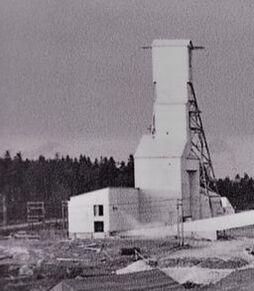
The Crusher house (white building to the left behind the conveyor in picture above)
Jeanette: When the ore went down to the shoot, it had to go from there into the crusher. It would be going from the conveyor into the crusher.
Wendell: There wasn’t many on a shift. John Cameron worked in the crusher house and MacDougall. He had a little house next to Danny Shaw’s store. He worked at the crusher. On a shift there may only be three in the crusher house.
Jeanette: So, when that ore would go into that hole, there would be some kind of machinery, a conveyor or something to take it into the crusher.
Wendell: It would go on electric belts, conveyor belts.
Bunkhouses and ram pastures
Jeanette: When the ore went down to the shoot, it had to go from there into the crusher. It would be going from the conveyor into the crusher.
Wendell: There wasn’t many on a shift. John Cameron worked in the crusher house and MacDougall. He had a little house next to Danny Shaw’s store. He worked at the crusher. On a shift there may only be three in the crusher house.
Jeanette: So, when that ore would go into that hole, there would be some kind of machinery, a conveyor or something to take it into the crusher.
Wendell: It would go on electric belts, conveyor belts.
Bunkhouses and ram pastures
Jeanette: This building here (dark building with the cars parked next to it). Do you know what that one was?
Wendell: It was one of the(older) bunk houses. One of the ram pastures; we used to call them. There was that one and I think there were two more.
Jeanette: The theatre was one of them.
Wendell: Yeah
Jeanette: And then there was one a little closer to the gate.
Wendell: That would have been this one maybe (the white building next to the older bunk house)
Jeanette: It doesn’t seem to be the same kind of building.
Wendell: That was a bunkhouse too I guess.
Wendell: See before these (the big bunkhouses) … When I went down in 51, they were just starting to open these up. There were some staying in them (the old bunk houses).
Jeanette: Did you ever stay in one of these bunkhouses?
Wendell: Oh yes. I stayed in both. I stayed in the Ram Pasture first then I moved (into the big one).
Jeanette: What were they like?
Wendell: They were nice. They had rooms on each side.
Jeanette: Did everybody have their own room?
Wendell: There were two beds in each room. They’d be like single beds.
Jeanette: Would there be a bathroom?
Wendell: There was a big bathroom on each floor. There were I guess three toilets, showers and a bunch of sinks. There were three or four sinks along the wall.
Wendell: After the big bunkhouses were built they didn’t use them (the older ones) very much.
Jeanette: They used one for a theatre. and then there was one maybe before this house, down from the Chinese Restaurant, there would have been another one, right?
Wendell: You can see a building, this building here (the smaller white house).
Jeanette: That looks almost like a house.
Wendell: That might be where MacDougall lived. He lived just below Danny Shaw’s store.
Jeanette: OK
Wendell: I know he had a little house there. I have his picture here.
Jeanette: There’s another little house there.
Wendell: That might have been a bunkhouse. There’s a guardhouse right here.
Jeanette: Yeah, a little guardhouse.
Wendell: It was one of the(older) bunk houses. One of the ram pastures; we used to call them. There was that one and I think there were two more.
Jeanette: The theatre was one of them.
Wendell: Yeah
Jeanette: And then there was one a little closer to the gate.
Wendell: That would have been this one maybe (the white building next to the older bunk house)
Jeanette: It doesn’t seem to be the same kind of building.
Wendell: That was a bunkhouse too I guess.
Wendell: See before these (the big bunkhouses) … When I went down in 51, they were just starting to open these up. There were some staying in them (the old bunk houses).
Jeanette: Did you ever stay in one of these bunkhouses?
Wendell: Oh yes. I stayed in both. I stayed in the Ram Pasture first then I moved (into the big one).
Jeanette: What were they like?
Wendell: They were nice. They had rooms on each side.
Jeanette: Did everybody have their own room?
Wendell: There were two beds in each room. They’d be like single beds.
Jeanette: Would there be a bathroom?
Wendell: There was a big bathroom on each floor. There were I guess three toilets, showers and a bunch of sinks. There were three or four sinks along the wall.
Wendell: After the big bunkhouses were built they didn’t use them (the older ones) very much.
Jeanette: They used one for a theatre. and then there was one maybe before this house, down from the Chinese Restaurant, there would have been another one, right?
Wendell: You can see a building, this building here (the smaller white house).
Jeanette: That looks almost like a house.
Wendell: That might be where MacDougall lived. He lived just below Danny Shaw’s store.
Jeanette: OK
Wendell: I know he had a little house there. I have his picture here.
Jeanette: There’s another little house there.
Wendell: That might have been a bunkhouse. There’s a guardhouse right here.
Jeanette: Yeah, a little guardhouse.
The pumping/piping system
Jeanette: So, Johnny Strachan worked there too?.
Wendell: He used to look after the pumps, from pumping over at the lake and I guess he worked underground after that.
Jeanette: So, he’d be over at the pump house.
Wendell: When he was first there, that’s what he was doing and then he might have worked underground after that. Or, he could have been doing that all the time, I don’t know.
Jeanette: As far as the water, do you know if the water came from anywhere else. That brook that was over near the Glory hole. Was there any water redirected into the mine?
Wendell: I don’t know, could have been. I don’t think so. It all came from the lake. It was big pipe. I think it was wood, a wooden pipe.
Jeanette: That’s what other people are saying. Note: See Chrissie and Duncan’s interview and Douglas Landry’s interview. It almost looks like Bamboo or pieces of wood tied together.
Wendell: Clamped together, maybe 8-10 inches (in diameter). It was a big pump over at that lake.
Jeanette: Would that go everywhere? Or would it go- the boiler house -it would need water there, right?
Wendell: Oh, Yeah. I know, it came- there was a tank up on the hill, up by the mill. I think it got pumped to there first. That big tank, then it came down by gravity. It must have come down by gravity. I remember having to go up there in wintertime, the mill. It used to freeze. There was a float there. When the thing went low, I guess it would have to pump it into the tank. Sometimes it used to freeze. We’d have to go up and check it, if they lost the water in the mill.
Jeanette: And what would you have to do with it?
Wendell: Oh, give it a little bang so she’d let go. There’s one picture there that shows it there (the tip)
Wendell: See there’s no sign of the mill there. The tank was up above the mill It was right up here. Wendell referring to photo of backside of mill behind the mill on the left side of the mill.
Wendell: It’s hard to see that tank.
Jeanette: But there were some other buildings -the carpenter shop and stuff like that in behind there somewhere and they aren’t showing.
Wendell: Yeah
Jeanette: I wonder why they wouldn’t have had a tower closer to the Stirling lake (rather) then way up on the hill there.
Wendell: I guess, the mill used a lot of water, it must have come down by gravity. Or maybe there was – I don’t’ remember a pump being up by the tank. I remember the lake pump used to pump water into the tank too and the water line supplied the whole mill with water from the tank I guess.
Wendell You can just see it there (the tip). You can barely see it (see area circled on picture below).
Jeanette I thought that might be part of the roof on one of those houses (behind the bunkhouses)
Wendell: You can barely see it. The houses would have been up towards the road.
Jeanette: Up that way a little bit (to the left in the picture)
Wendell: Yeah
Jeanette: So, Johnny Strachan worked there too?.
Wendell: He used to look after the pumps, from pumping over at the lake and I guess he worked underground after that.
Jeanette: So, he’d be over at the pump house.
Wendell: When he was first there, that’s what he was doing and then he might have worked underground after that. Or, he could have been doing that all the time, I don’t know.
Jeanette: As far as the water, do you know if the water came from anywhere else. That brook that was over near the Glory hole. Was there any water redirected into the mine?
Wendell: I don’t know, could have been. I don’t think so. It all came from the lake. It was big pipe. I think it was wood, a wooden pipe.
Jeanette: That’s what other people are saying. Note: See Chrissie and Duncan’s interview and Douglas Landry’s interview. It almost looks like Bamboo or pieces of wood tied together.
Wendell: Clamped together, maybe 8-10 inches (in diameter). It was a big pump over at that lake.
Jeanette: Would that go everywhere? Or would it go- the boiler house -it would need water there, right?
Wendell: Oh, Yeah. I know, it came- there was a tank up on the hill, up by the mill. I think it got pumped to there first. That big tank, then it came down by gravity. It must have come down by gravity. I remember having to go up there in wintertime, the mill. It used to freeze. There was a float there. When the thing went low, I guess it would have to pump it into the tank. Sometimes it used to freeze. We’d have to go up and check it, if they lost the water in the mill.
Jeanette: And what would you have to do with it?
Wendell: Oh, give it a little bang so she’d let go. There’s one picture there that shows it there (the tip)
Wendell: See there’s no sign of the mill there. The tank was up above the mill It was right up here. Wendell referring to photo of backside of mill behind the mill on the left side of the mill.
Wendell: It’s hard to see that tank.
Jeanette: But there were some other buildings -the carpenter shop and stuff like that in behind there somewhere and they aren’t showing.
Wendell: Yeah
Jeanette: I wonder why they wouldn’t have had a tower closer to the Stirling lake (rather) then way up on the hill there.
Wendell: I guess, the mill used a lot of water, it must have come down by gravity. Or maybe there was – I don’t’ remember a pump being up by the tank. I remember the lake pump used to pump water into the tank too and the water line supplied the whole mill with water from the tank I guess.
Wendell You can just see it there (the tip). You can barely see it (see area circled on picture below).
Jeanette I thought that might be part of the roof on one of those houses (behind the bunkhouses)
Wendell: You can barely see it. The houses would have been up towards the road.
Jeanette: Up that way a little bit (to the left in the picture)
Wendell: Yeah
This picture here. That was taken
Jeanette: “Old shaft/CAGE”
Jeanette: “Old shaft/CAGE”
Jeanette: So, look (at the sign), “stop, parking here. No private vehicles allowed”. Dolena was saying that she didn't think you were allowed to have a vehicle go past the office.
Wendell: No. You weren’t supposed to unless you were working down there or something. Although, we used to park down there, at the gate.
Jeanette So what were you saying about that picture. You have the office (written) there. What were you saying about the shaft?
Wendell: They had a temporary wooden headframe up when they were sinking the new shaft.
Jeanette: I see that’s the beginning of it (in background).
Wendell: Yeah
Jeanette: Ah, I see. That’s where that little building is, you don’t see it anymore but it’s in one of the other pictures.
Wendell; The guardhouse wasn’t there then. Or maybe the guardhouse was here. It was around here, back this way (to the left).
Jeanette: So that’s where those cars are parked (from photo #2) right there.
Wendell: Yeah.
Jeanette: The gatehouse (should be) right in front of that? They probably hadn’t built it yet.
Wendell: No, it would have been here I guess. There was no gatehouse, so that would have been pretty early.
Jeanette: Yeah
Wendell: It would have been early 51.
Wendell: No. You weren’t supposed to unless you were working down there or something. Although, we used to park down there, at the gate.
Jeanette So what were you saying about that picture. You have the office (written) there. What were you saying about the shaft?
Wendell: They had a temporary wooden headframe up when they were sinking the new shaft.
Jeanette: I see that’s the beginning of it (in background).
Wendell: Yeah
Jeanette: Ah, I see. That’s where that little building is, you don’t see it anymore but it’s in one of the other pictures.
Wendell; The guardhouse wasn’t there then. Or maybe the guardhouse was here. It was around here, back this way (to the left).
Jeanette: So that’s where those cars are parked (from photo #2) right there.
Wendell: Yeah.
Jeanette: The gatehouse (should be) right in front of that? They probably hadn’t built it yet.
Wendell: No, it would have been here I guess. There was no gatehouse, so that would have been pretty early.
Jeanette: Yeah
Wendell: It would have been early 51.
Jeanette: So this picture (above ) are of the same bunk houses but taken from the other direction (coming up the mine road.
Wendell: Yeah
Wendell: Yeah
Wendell: And here that old picture, those houses up on the hill there (to the left). Those big houses. This is where the bosses lived, I think. This is the old mine now (1930's).
Jeanette: But there’s also…
Wendell: Some here (background left).
Jeanette: I don’t know where they went. I was talking to a man, Bob Presseau. His father was a mine manager in the 30’s. He said something about one of the (big) houses being down on Argyle street (Sydney).
Wendell: Oh, could be.
Wendell; This (on the foreground left) must be the area where the new bunkhouses were (in the 50’s).
Jeanette: That looks like it, up on that hill.
Jeanette: But there’s also…
Wendell: Some here (background left).
Jeanette: I don’t know where they went. I was talking to a man, Bob Presseau. His father was a mine manager in the 30’s. He said something about one of the (big) houses being down on Argyle street (Sydney).
Wendell: Oh, could be.
Wendell; This (on the foreground left) must be the area where the new bunkhouses were (in the 50’s).
Jeanette: That looks like it, up on that hill.
Jeanette: So, just back to one of these pictures (above). The mill is back here. So why were these things (conveyors) on an angle going up like this?
Wendell: I guess to make room for the concentrate to come out. Zinc came out of one and the lead and copper came out of another one.
Jeanette: So, there was like two silos holding it, probably holding it till they came (the trucks).
Wendell: It came from the filters. That was where the final … and it was just like a sand.
Jeanette: So, the filters were…
Wendell: In the mill.
Jeanette: So, there must have been a belt or something moving it?
Wendell: Yes, the conveyor belts going up.
Jeanette: And you see the truck here. There must have been a shoot or something here, allowing so much to come down.
Wendell: I know Billy Man was on the loader but most of the time it was daytime when they hauled. I know when the roads would be closed in the Spring they’d have a lot to ship and when the roads opened they’d be hauling day and night until they got caught up.
Jeanette: Would they haul through Grand River?
Wendell: Through here (Grand River), and out the Lewis Cove Road.
Jeanette: They used the 8-mile stretch (to Loch Lomond sometimes.
Wendell: They used to go that way the odd time, yeah. I used to go the 8 mile stretch a lot. It was the same distance you know. The road wasn’t too bad. It wasn’t great.
Jeanette: There was a story about that. Jamie (MacDonald) said when they were younger, they’d be walking along the road there (in Loch Lomond). They’d find the balls when they were bringing in the balls for the ball mill.
Wendell: Could be
Jeanette: And there would be balls this big about 2 ½ inches round.
Wendell: They would have been hauling them in I guess from Sydney.
Wendell: The ball mill – there were different size balls. There were bigger steel balls and smaller ones.
Jeanette: Yes, that’s what he was saying. Jamie worked in the mine in Loch Lomond and he was familiar with the process.
Jeanette: They (the balls) after a while would get (too) small and they’d have to replace them.
Wendell: And they wore down to ..
Jeanette: Nothing basically. We found some about this size (one inch).
Wendell: I remember Havelock Shepard. He worked on the ball mill and Charlie did too.
Jeanette: And they were from where, Fourchu?
Wendell: Yeah. And I think every day or so, I think, you had to put so many pounds of balls in the mill to make up for those that got worn out.
Jeanette: and where would they be stored.
Wendell: They’d have then at the mill there, in a bin or on the ground, piles of them. They’d weigh them. So many would go in every day or every week.J
Wendell: I guess to make room for the concentrate to come out. Zinc came out of one and the lead and copper came out of another one.
Jeanette: So, there was like two silos holding it, probably holding it till they came (the trucks).
Wendell: It came from the filters. That was where the final … and it was just like a sand.
Jeanette: So, the filters were…
Wendell: In the mill.
Jeanette: So, there must have been a belt or something moving it?
Wendell: Yes, the conveyor belts going up.
Jeanette: And you see the truck here. There must have been a shoot or something here, allowing so much to come down.
Wendell: I know Billy Man was on the loader but most of the time it was daytime when they hauled. I know when the roads would be closed in the Spring they’d have a lot to ship and when the roads opened they’d be hauling day and night until they got caught up.
Jeanette: Would they haul through Grand River?
Wendell: Through here (Grand River), and out the Lewis Cove Road.
Jeanette: They used the 8-mile stretch (to Loch Lomond sometimes.
Wendell: They used to go that way the odd time, yeah. I used to go the 8 mile stretch a lot. It was the same distance you know. The road wasn’t too bad. It wasn’t great.
Jeanette: There was a story about that. Jamie (MacDonald) said when they were younger, they’d be walking along the road there (in Loch Lomond). They’d find the balls when they were bringing in the balls for the ball mill.
Wendell: Could be
Jeanette: And there would be balls this big about 2 ½ inches round.
Wendell: They would have been hauling them in I guess from Sydney.
Wendell: The ball mill – there were different size balls. There were bigger steel balls and smaller ones.
Jeanette: Yes, that’s what he was saying. Jamie worked in the mine in Loch Lomond and he was familiar with the process.
Jeanette: They (the balls) after a while would get (too) small and they’d have to replace them.
Wendell: And they wore down to ..
Jeanette: Nothing basically. We found some about this size (one inch).
Wendell: I remember Havelock Shepard. He worked on the ball mill and Charlie did too.
Jeanette: And they were from where, Fourchu?
Wendell: Yeah. And I think every day or so, I think, you had to put so many pounds of balls in the mill to make up for those that got worn out.
Jeanette: and where would they be stored.
Wendell: They’d have then at the mill there, in a bin or on the ground, piles of them. They’d weigh them. So many would go in every day or every week.J
Note: See picture above of balls found recently at the Stirling mine site. Notice the different sizes as explained above.
Jeanette: So, that explains that. Now, the gas pumps…
Wendell: Yes, they had the gas pumps.
Jeanette: Who would be getting gas?
Wendell: For the company trucks and the company machines.
Jeanette: This little truck here. Do you think that was …?
Wendell: I think that was Malcolm MacDonald’s. It looks like a Rio. They had Rio trucks hauling.
Jeanette: There were trucks on the site. There were Internationals. And they had Macks.
Wendell: Angus Archie (drove one). I think they had two of those one time and they had a Mack. They had a big Mack.
Jeanette: So, there were two trucks which carried ore to St Peter’s.
Wendell: They started with two of their own trucks, but they didn’t haul a year, or less, and then they took them off. Then it was all MacDonald’s.
Jeanette; Murdock Morrison said they had two mine trucks and then they had five of Malcolm S’s.
Wendell: Yeah. In later years, it was all Malcolm’s.
Jeanette: So, that explains that. Now, the gas pumps…
Wendell: Yes, they had the gas pumps.
Jeanette: Who would be getting gas?
Wendell: For the company trucks and the company machines.
Jeanette: This little truck here. Do you think that was …?
Wendell: I think that was Malcolm MacDonald’s. It looks like a Rio. They had Rio trucks hauling.
Jeanette: There were trucks on the site. There were Internationals. And they had Macks.
Wendell: Angus Archie (drove one). I think they had two of those one time and they had a Mack. They had a big Mack.
Jeanette: So, there were two trucks which carried ore to St Peter’s.
Wendell: They started with two of their own trucks, but they didn’t haul a year, or less, and then they took them off. Then it was all MacDonald’s.
Jeanette; Murdock Morrison said they had two mine trucks and then they had five of Malcolm S’s.
Wendell: Yeah. In later years, it was all Malcolm’s.
Jeanette: Does this look familiar to you (picture above)?
Wendell: That would be in the mill.
Wendell: That’s a picture of one of the floatations, That’s the floatations. They’re big tanks, long tanks and this is like a big eggbeater thing run by electric motors and belts.
Jeanette: Yeah, on the left-hand side of that big beam of wood. On the left-hand side there is that…
Wendell: that’s just a beam of wood and the wires. They’d cover the switches so they wouldn’t get wet. And this – the flotations overflow in the little paddles here. It took it off, the foam, and it went down in a shoot here and went into another tank.
Jeanette: And this is a pulley of some sort (right hand side)
Wendell: That would be another motor, I guess, that’s driving/hauling the stuff into an auger type thing.
Wendell: That would be in the mill.
Wendell: That’s a picture of one of the floatations, That’s the floatations. They’re big tanks, long tanks and this is like a big eggbeater thing run by electric motors and belts.
Jeanette: Yeah, on the left-hand side of that big beam of wood. On the left-hand side there is that…
Wendell: that’s just a beam of wood and the wires. They’d cover the switches so they wouldn’t get wet. And this – the flotations overflow in the little paddles here. It took it off, the foam, and it went down in a shoot here and went into another tank.
Jeanette: And this is a pulley of some sort (right hand side)
Wendell: That would be another motor, I guess, that’s driving/hauling the stuff into an auger type thing.
Wendell's photo of the locker room.
Wendell: This is where the crushed ore went into the ore tank, right up on the top, on the top of the conveyor.
Jeanette: That’s where that young fellow got caught, right?
Wendell; That’s where Howard Burns got killed.
Jeanette: He got caught in the pulley.
Wendell: He got caught in the pulley, the head pulley. He went right around and instantly killed him.
Jeanette: And did he go into one of those big tanks?
Wendell: No. He was jammed and the motor kicked out. John Cameron was working down below in the crusher house and the belt stopped. He didn’t know what had happened. Sometimes, if you have trouble you have to stop the belt. The belt stopped and he didn’t know what was going on. He didn’t see anybody, so he walked up and found Howard in there.
Jeanette: Ahh
Wendell: That was in December, just a few weeks before Christmas.
Jeanette: That was a sad thing.Jeanette: What was Howard Burns doing up there on the top (of the conveyor).
Wendell: He was just changing the shoot. There would be someone up there, most of the time, when they were crushing, they would fill one tank then change the shoot (over to the next tank).
Jeanette: So how do you suppose he got caught up in that?
Wendell: I don’t know. Sometimes the bearings would get hot and you would check them. The bearings may have been getting hot and needed grease and he may have fell into the belt. It was in the evening 4-12 shift. On a Saturday night.
Other people who died in the mine when it ran in the 50's
Jeanette: You have a lot more names than I have heard before.
Wendell: There was one fellow from Quebec. He was on a mucking machine. He got killed. He wasn’t there that long.
Jeanette: Do you remember what his name was? There was a Bedard (who got killed).
Wendell: Could have been. He was fairly young. I remember there was a bunch of them came. It’s funny what you remember. Two of the guys, I don’t know if they were brothers or what, but they would play one guitar. One would play and the other fellow was on the bed and he’d play the same guitar with him. I never saw it before. They were from Valdor, Quebec. They were only young. I don’t know if it was one of them that got killed. This fellow who got killed, wasn’t there that long.
Jeanette: Angus was telling me one person, maybe that’s what he was on, the mucker machine, that it had a bucket and he was banging it up against the wall
Wendell: Something caved in on him or rock fell on him.
Wendell: The other fellow who got killed was from up Stellerton, around the New Glasgow area. I think someone said he had been a policeman up there. Then he went to Stirling and got killed by a fallen rock, I think. I’m trying to think if there was anyone else.
Jeanette: That’s where that young fellow got caught, right?
Wendell; That’s where Howard Burns got killed.
Jeanette: He got caught in the pulley.
Wendell: He got caught in the pulley, the head pulley. He went right around and instantly killed him.
Jeanette: And did he go into one of those big tanks?
Wendell: No. He was jammed and the motor kicked out. John Cameron was working down below in the crusher house and the belt stopped. He didn’t know what had happened. Sometimes, if you have trouble you have to stop the belt. The belt stopped and he didn’t know what was going on. He didn’t see anybody, so he walked up and found Howard in there.
Jeanette: Ahh
Wendell: That was in December, just a few weeks before Christmas.
Jeanette: That was a sad thing.Jeanette: What was Howard Burns doing up there on the top (of the conveyor).
Wendell: He was just changing the shoot. There would be someone up there, most of the time, when they were crushing, they would fill one tank then change the shoot (over to the next tank).
Jeanette: So how do you suppose he got caught up in that?
Wendell: I don’t know. Sometimes the bearings would get hot and you would check them. The bearings may have been getting hot and needed grease and he may have fell into the belt. It was in the evening 4-12 shift. On a Saturday night.
Other people who died in the mine when it ran in the 50's
Jeanette: You have a lot more names than I have heard before.
Wendell: There was one fellow from Quebec. He was on a mucking machine. He got killed. He wasn’t there that long.
Jeanette: Do you remember what his name was? There was a Bedard (who got killed).
Wendell: Could have been. He was fairly young. I remember there was a bunch of them came. It’s funny what you remember. Two of the guys, I don’t know if they were brothers or what, but they would play one guitar. One would play and the other fellow was on the bed and he’d play the same guitar with him. I never saw it before. They were from Valdor, Quebec. They were only young. I don’t know if it was one of them that got killed. This fellow who got killed, wasn’t there that long.
Jeanette: Angus was telling me one person, maybe that’s what he was on, the mucker machine, that it had a bucket and he was banging it up against the wall
Wendell: Something caved in on him or rock fell on him.
Wendell: The other fellow who got killed was from up Stellerton, around the New Glasgow area. I think someone said he had been a policeman up there. Then he went to Stirling and got killed by a fallen rock, I think. I’m trying to think if there was anyone else.
Photo Charlie and Wendell
That’s Charlie and myself.
Jeanette: And what were you doing there?
Wendell: Filling those feeders- floatation helper. Those little feeders would send chemicals into the floatation.
Jeanette: So, you’d just watch to make sure everything was working OK?
Wendell: Yeah. Some of them you had to fill by hand, and some were automatic in a tank.
That’s Charlie and myself.
Jeanette: And what were you doing there?
Wendell: Filling those feeders- floatation helper. Those little feeders would send chemicals into the floatation.
Jeanette: So, you’d just watch to make sure everything was working OK?
Wendell: Yeah. Some of them you had to fill by hand, and some were automatic in a tank.
Wendell: You’ll see there’s more of the floatations, electric motors.
Wendell' There's a picture of the ball mill.
Wendell: That there, it's called the classifier. After it went through the ball mills big Cogs turned it and a lot of water added to it.
Wendell: another classifier over there and then they would overflow into a shoot here.
Wendell: That there, it's called the classifier. After it went through the ball mills big Cogs turned it and a lot of water added to it.
Wendell: another classifier over there and then they would overflow into a shoot here.
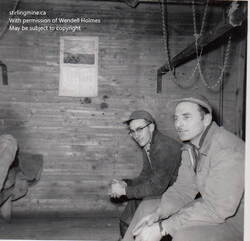
Photo Laurie Fanning and Malcolm MacDonald (above)
His name is there, Laurie Fanning. He was a shift boss and Malcolm MacDonald. They were up in the change room.
Jeanette: The change room
Wendell: It was upstairs in the mill. Right here, there it was there. There are the lockers.
Jeanette: Oh, upstairs in the mill was the changeroom!
Wendell: Yes, up above, just on the second floor.
Jeanette: Everybody changed there?
Wendell: Yes, and the office was up there. Callaway was the head boss. The second guy, I can’t remember his name.
Jeanette: The Miners, they wouldn’t change there?
Wendell: No. It was just for the Mill.
His name is there, Laurie Fanning. He was a shift boss and Malcolm MacDonald. They were up in the change room.
Jeanette: The change room
Wendell: It was upstairs in the mill. Right here, there it was there. There are the lockers.
Jeanette: Oh, upstairs in the mill was the changeroom!
Wendell: Yes, up above, just on the second floor.
Jeanette: Everybody changed there?
Wendell: Yes, and the office was up there. Callaway was the head boss. The second guy, I can’t remember his name.
Jeanette: The Miners, they wouldn’t change there?
Wendell: No. It was just for the Mill.
Lawrence Morrison and Alex Graham
There’s a name you’ll see in there (Wendel’s list), Alex Graham. He was another shift boss. He was from over Judique way.
Jeanette: What does a shift Boss do?
Wendell: Well he was boss of the mill. There was so many of us.
Jeanette: Who was that guy next to him
Wendell: That was Lawrence (Morrison).
There’s a name you’ll see in there (Wendel’s list), Alex Graham. He was another shift boss. He was from over Judique way.
Jeanette: What does a shift Boss do?
Wendell: Well he was boss of the mill. There was so many of us.
Jeanette: Who was that guy next to him
Wendell: That was Lawrence (Morrison).
Photo by JP Messerey (above)
That was the old (mine) when they were building it the first time. It’s say’s 1929 so I suppose that would be right.
Jeanette: I wonder who that Messerey was.
Wendell: I went on to the computer and I found he was a photographer and I think maybe he worked at the mine when he took the picture.
Jeanette: That’s pretty interesting how they got that all set up. That’s a nice picture.
Note: There is a similar picture on the NS government, Dept of Mines webpage by the same photographer. Click on link to access this page .http:://novascotiagold.ca/theme/exploitation_de_lor-mining/capebreton-eng.php
Jeanette: So that looks like an old mine shaft there, right there (background right).
Wendell: That was the original old shaft.
Jeanette: Is that the one we were looking at (before)
Wendell: Yeah the original old shaft. The mill wasn’t even built then.
Wendell: And this apparently was the powerhouse, where they generated the electricity. They would have had the big generators and the big diesel... See, they’re just building it. See the old cars there and the tractor. The mill wasn’t even built. The old mill and still I see a house up on the hill there (on the left).
Jeanette: Yeah, that’s a good one.
Jeanette: Look at the old cars, eh. You got a good picture of that.
That was the old (mine) when they were building it the first time. It’s say’s 1929 so I suppose that would be right.
Jeanette: I wonder who that Messerey was.
Wendell: I went on to the computer and I found he was a photographer and I think maybe he worked at the mine when he took the picture.
Jeanette: That’s pretty interesting how they got that all set up. That’s a nice picture.
Note: There is a similar picture on the NS government, Dept of Mines webpage by the same photographer. Click on link to access this page .http:://novascotiagold.ca/theme/exploitation_de_lor-mining/capebreton-eng.php
Jeanette: So that looks like an old mine shaft there, right there (background right).
Wendell: That was the original old shaft.
Jeanette: Is that the one we were looking at (before)
Wendell: Yeah the original old shaft. The mill wasn’t even built then.
Wendell: And this apparently was the powerhouse, where they generated the electricity. They would have had the big generators and the big diesel... See, they’re just building it. See the old cars there and the tractor. The mill wasn’t even built. The old mill and still I see a house up on the hill there (on the left).
Jeanette: Yeah, that’s a good one.
Jeanette: Look at the old cars, eh. You got a good picture of that.
Photo - Spinner’s shoehorn (above)
Jeanette: I see you have the old shoehorn from Spinner’s
Wendell: Yes. It was found at a yard sale in Halifax.
Jeanette: It says Spinner's Men's Shop. Sydney, NS - Stirling, NS.
Jeanette: I see you have the old shoehorn from Spinner’s
Wendell: Yes. It was found at a yard sale in Halifax.
Jeanette: It says Spinner's Men's Shop. Sydney, NS - Stirling, NS.
List of Names
Wendell: Here’s a list of the names.
Wendell: Collie MacKenzie. He had a place down near where Douglas Morrison lives now. He was a mechanic in the machine shop.
Jeanette: I have his name down but I didn’t have his first name
Wendell: Johnny MacAulay, Ester’s husband. He worked underground but he didn’t work but one year. He was a fisherman. He may have worked in the winter.
Wendell: Dan Alex (MacLeod), Martha’s brother, first, he worked around the bunkhouses and then he used to drive a service truck. Joe MacLean from Lock Lomond- he was on the bulldozer all the time. There was a man of the name of Bernie Cameron. He was a miner. Willie Ferguson, the Fiddler – He worked there. Danny Campbell – He was from Johnstown. He worked with me and then he went underground. Some fellows from Arichat worked there. Lee Holly - He was from Brook Village. He was a heavyset fellow. He worked in the shaft. Donald George Matheson. He worked in the shaft for a while and Duncan Dan down here, he worked in the shaft. They sank it so far (the first time) and then the next time they sunk it down I think a thousand feet. Adamson, now – he was from Point Michaud. His son lives down Point Michaud now. He is retired from the army. I don’t know his first name, but they used to call him “the Big Swede”. He had a big motorcycle. It’s the first time I ever saw a motorcycle going by here. He used to go by on the old motorcycle.
Jeanette: He was from Sweden?
Wendell: He was a Swede. I don’t know if he or his people were born over there. Anyway, we used to call him “the big Swede”. He was a miner when he came here, I guess. He may have worked in Ontario before that. He was married to a girl from L’Ardoise.
Jeanette: Do you remember a Dutchman who lived across from where my father’s garage (Strachan’s) was.
Wendell: I remember there was a man that lived in a little building there. When I went in 51. He lived down from Morrison’s store (on main road) just across from where the school was.
Jeanette: I think there were three houses there. That’s not the man I’m talking about. There was a road there I think he was in back further. (This man is likely Willie P. Morrison as per Duncan MacLeod’s interview).
Wendell: Roddie MacLeod had a little place on the way down to Barker’s corner on the left..
Jeanette: Did they call him Roddie John Alex?
Wendell: Yes
Wendell: Willie Ferguson – the Fiddler had a little cabin down there. He used to stay there.
Jeanette: Was that around where we called “Dogpatch”. Note: Dogpatch was a nickname given to this stretch of road as there were several homes in a large open field. The homes were often small and temporary with several people coming and going depending on what their job was at the mine. At the time there was a popular cartoon strip "L'il Abner" and the place they lived was called Dogpatch.
Wendell: Dogpatch, yeah.
Jeanette: Willie Ferguson
Wendell: Yeah, he had a little cabin there. He worked there off and on with John Cameron. They’d poured cement and stuff.
Jeanette Showing Wendell the map of Stirling road
Wendell: Lloyd MacRae. He was a character.
Jeanette: Where was he from?
Wendell: From over Oban. There was a bad windstorm they had over there (in Stirling). He said, “the wind was blowing so hard. It blew the handle out of the axe.” (laughter).
Jeanette:: Who was it (that was saying this)?
Wendell: It was Lloyd MacRae.
Wendell: Calvin Hasting’s. He and Malcolm were working on the lamps. He had one of those Bugs – a Volkswagon. That was the first time I had seen one of them 1954-1955 I think.
Jeanette: Pearl MacLeod said, that he drove very fast. He was supposed to be really funny and he worked in the main office.
Wendell: Hastings?
Jeanette: Yeah
Wendell: Hastings. He was a lampman.
Jeanette: Bessie said he worked in the office.
Wendell: He may have later, but he worked with Malcolm doing the lamps.
Jeanette: And then there was a guy who was called the Cowboy.
Wendell: I don’t know who that would have been.
Jeanette: Back to the map and along this stretch. I don’t have them in order but there was a log Cabin that Angus MacLeod and Lawrence Morrison built.
Wendell: Yeah
Jeanette: And then Elsie and John Archie Munroe were beside Adelaide and Dan Alex Burns.
Wendell Yeah
Jeanette; And their son Howard, I think, had a little place there before he died. And Roddie John Alex (MacLeod) and Johnny Martell and his wife.
Wendell: Yeah, John Martell. He was a Diamond driller.
Jeanette: I was talking to his son. He said he was a Diamond Driller.
Jeanette: So, there were Diamond drillers who worked for the Dept of Mines, too, like Johnny MacMillan, right?
Wendell: Yeah. They were there mostly when it started (in the 50’s).
Wendell: Buddy MacDonald. He drove a service truck.
Wendell: Peter John H (MacLeod) worked there. I don’t think he worked for the mine. He drove his own truck (contractor). Another fellow who worked there was MacLean from Gabarus, Angus MacLean maybe. Jack MacLean was his brother – the mayor of Sydney.
Jeanette: What did he do?
Wendell: He had an old Ford dump truck. He used to work as a service truck, go down the beach and haul sand for mixing cement.
Jeanette: Was he doing private (contracting)?
Wendell: He just worked for himself. He didn’t work for the company.
Jeanette: I guess there were a lot of entrepreneurs who made a lot of money of that (the mine).
Wendell: Oh, yeah.
Wendell: Here’s a list of the names.
Wendell: Collie MacKenzie. He had a place down near where Douglas Morrison lives now. He was a mechanic in the machine shop.
Jeanette: I have his name down but I didn’t have his first name
Wendell: Johnny MacAulay, Ester’s husband. He worked underground but he didn’t work but one year. He was a fisherman. He may have worked in the winter.
Wendell: Dan Alex (MacLeod), Martha’s brother, first, he worked around the bunkhouses and then he used to drive a service truck. Joe MacLean from Lock Lomond- he was on the bulldozer all the time. There was a man of the name of Bernie Cameron. He was a miner. Willie Ferguson, the Fiddler – He worked there. Danny Campbell – He was from Johnstown. He worked with me and then he went underground. Some fellows from Arichat worked there. Lee Holly - He was from Brook Village. He was a heavyset fellow. He worked in the shaft. Donald George Matheson. He worked in the shaft for a while and Duncan Dan down here, he worked in the shaft. They sank it so far (the first time) and then the next time they sunk it down I think a thousand feet. Adamson, now – he was from Point Michaud. His son lives down Point Michaud now. He is retired from the army. I don’t know his first name, but they used to call him “the Big Swede”. He had a big motorcycle. It’s the first time I ever saw a motorcycle going by here. He used to go by on the old motorcycle.
Jeanette: He was from Sweden?
Wendell: He was a Swede. I don’t know if he or his people were born over there. Anyway, we used to call him “the big Swede”. He was a miner when he came here, I guess. He may have worked in Ontario before that. He was married to a girl from L’Ardoise.
Jeanette: Do you remember a Dutchman who lived across from where my father’s garage (Strachan’s) was.
Wendell: I remember there was a man that lived in a little building there. When I went in 51. He lived down from Morrison’s store (on main road) just across from where the school was.
Jeanette: I think there were three houses there. That’s not the man I’m talking about. There was a road there I think he was in back further. (This man is likely Willie P. Morrison as per Duncan MacLeod’s interview).
Wendell: Roddie MacLeod had a little place on the way down to Barker’s corner on the left..
Jeanette: Did they call him Roddie John Alex?
Wendell: Yes
Wendell: Willie Ferguson – the Fiddler had a little cabin down there. He used to stay there.
Jeanette: Was that around where we called “Dogpatch”. Note: Dogpatch was a nickname given to this stretch of road as there were several homes in a large open field. The homes were often small and temporary with several people coming and going depending on what their job was at the mine. At the time there was a popular cartoon strip "L'il Abner" and the place they lived was called Dogpatch.
Wendell: Dogpatch, yeah.
Jeanette: Willie Ferguson
Wendell: Yeah, he had a little cabin there. He worked there off and on with John Cameron. They’d poured cement and stuff.
Jeanette Showing Wendell the map of Stirling road
Wendell: Lloyd MacRae. He was a character.
Jeanette: Where was he from?
Wendell: From over Oban. There was a bad windstorm they had over there (in Stirling). He said, “the wind was blowing so hard. It blew the handle out of the axe.” (laughter).
Jeanette:: Who was it (that was saying this)?
Wendell: It was Lloyd MacRae.
Wendell: Calvin Hasting’s. He and Malcolm were working on the lamps. He had one of those Bugs – a Volkswagon. That was the first time I had seen one of them 1954-1955 I think.
Jeanette: Pearl MacLeod said, that he drove very fast. He was supposed to be really funny and he worked in the main office.
Wendell: Hastings?
Jeanette: Yeah
Wendell: Hastings. He was a lampman.
Jeanette: Bessie said he worked in the office.
Wendell: He may have later, but he worked with Malcolm doing the lamps.
Jeanette: And then there was a guy who was called the Cowboy.
Wendell: I don’t know who that would have been.
Jeanette: Back to the map and along this stretch. I don’t have them in order but there was a log Cabin that Angus MacLeod and Lawrence Morrison built.
Wendell: Yeah
Jeanette: And then Elsie and John Archie Munroe were beside Adelaide and Dan Alex Burns.
Wendell Yeah
Jeanette; And their son Howard, I think, had a little place there before he died. And Roddie John Alex (MacLeod) and Johnny Martell and his wife.
Wendell: Yeah, John Martell. He was a Diamond driller.
Jeanette: I was talking to his son. He said he was a Diamond Driller.
Jeanette: So, there were Diamond drillers who worked for the Dept of Mines, too, like Johnny MacMillan, right?
Wendell: Yeah. They were there mostly when it started (in the 50’s).
Wendell: Buddy MacDonald. He drove a service truck.
Wendell: Peter John H (MacLeod) worked there. I don’t think he worked for the mine. He drove his own truck (contractor). Another fellow who worked there was MacLean from Gabarus, Angus MacLean maybe. Jack MacLean was his brother – the mayor of Sydney.
Jeanette: What did he do?
Wendell: He had an old Ford dump truck. He used to work as a service truck, go down the beach and haul sand for mixing cement.
Jeanette: Was he doing private (contracting)?
Wendell: He just worked for himself. He didn’t work for the company.
Jeanette: I guess there were a lot of entrepreneurs who made a lot of money of that (the mine).
Wendell: Oh, yeah.
